Cluster 1 - Wellbeing & Safety
VerifiedAdded on 2023/01/17
|38
|10247
|37
AI Summary
This cluster focuses on the skills and knowledge required by educators working with children to ensure and maintain a safe and healthy environment. It also explores supporting and protecting children and young people at risk.
Contribute Materials
Your contribution can guide someone’s learning journey. Share your
documents today.
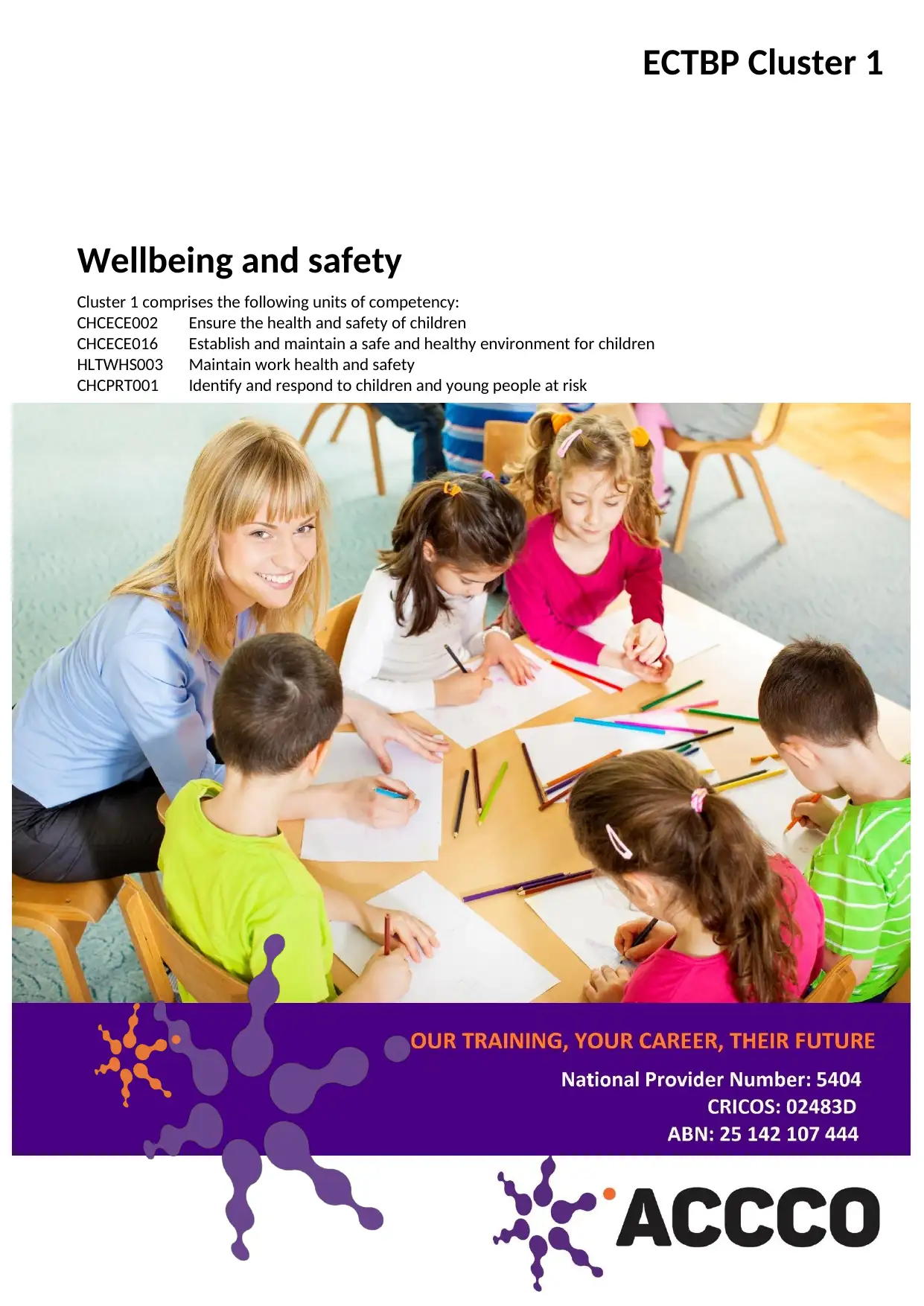
Wellbeing and safety
Cluster 1 comprises the following units of competency:
CHCECE002 Ensure the health and safety of children
CHCECE016 Establish and maintain a safe and healthy environment for children
HLTWHS003 Maintain work health and safety
CHCPRT001 Identify and respond to children and young people at risk
ECTBP Cluster 1
Cluster 1 comprises the following units of competency:
CHCECE002 Ensure the health and safety of children
CHCECE016 Establish and maintain a safe and healthy environment for children
HLTWHS003 Maintain work health and safety
CHCPRT001 Identify and respond to children and young people at risk
ECTBP Cluster 1
Secure Best Marks with AI Grader
Need help grading? Try our AI Grader for instant feedback on your assignments.
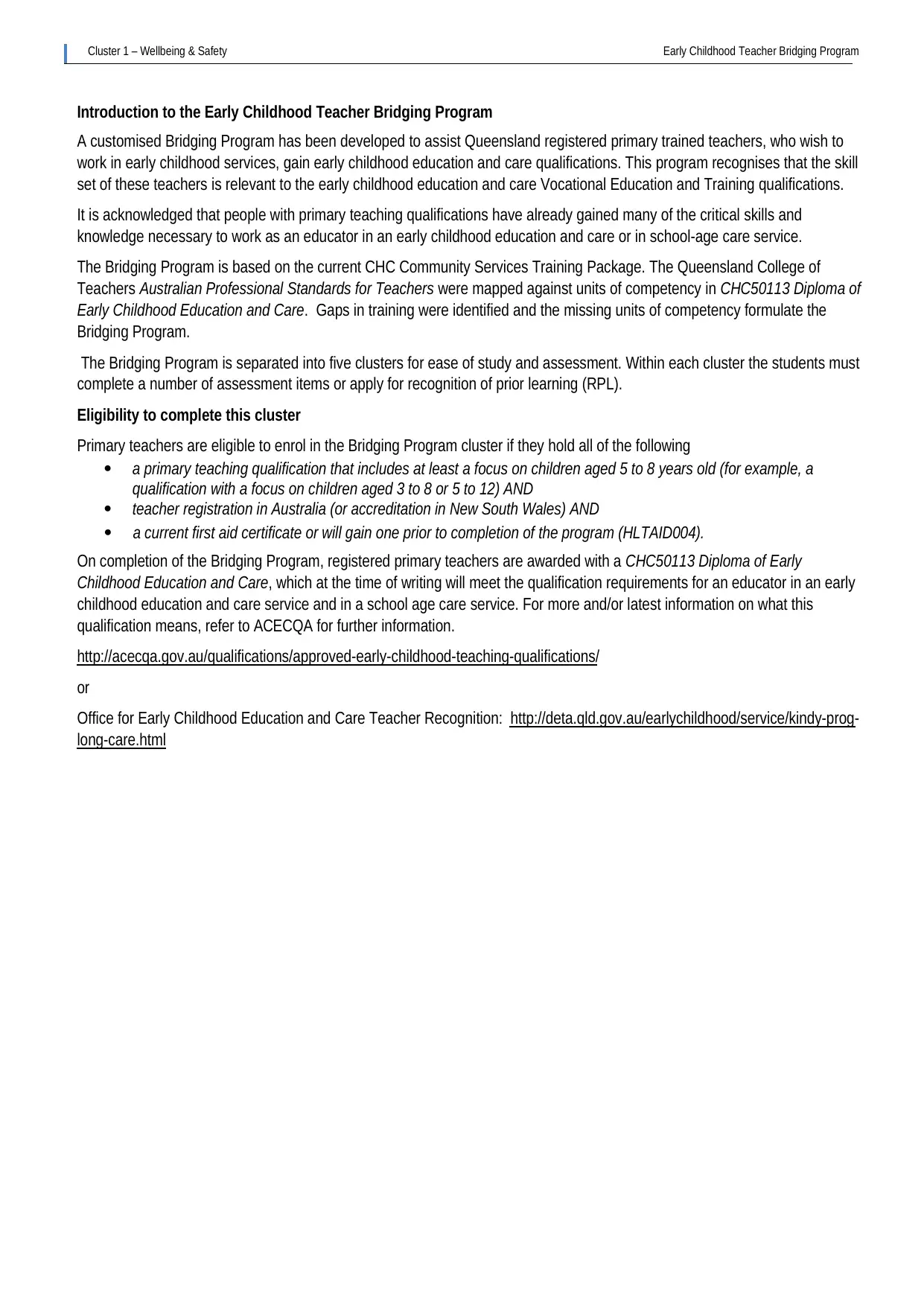
Cluster 1 – Wellbeing & Safety Early Childhood Teacher Bridging Program
Introduction to the Early Childhood Teacher Bridging Program
A customised Bridging Program has been developed to assist Queensland registered primary trained teachers, who wish to
work in early childhood services, gain early childhood education and care qualifications. This program recognises that the skill
set of these teachers is relevant to the early childhood education and care Vocational Education and Training qualifications.
It is acknowledged that people with primary teaching qualifications have already gained many of the critical skills and
knowledge necessary to work as an educator in an early childhood education and care or in school-age care service.
The Bridging Program is based on the current CHC Community Services Training Package. The Queensland College of
Teachers Australian Professional Standards for Teachers were mapped against units of competency in CHC50113 Diploma of
Early Childhood Education and Care. Gaps in training were identified and the missing units of competency formulate the
Bridging Program.
The Bridging Program is separated into five clusters for ease of study and assessment. Within each cluster the students must
complete a number of assessment items or apply for recognition of prior learning (RPL).
Eligibility to complete this cluster
Primary teachers are eligible to enrol in the Bridging Program cluster if they hold all of the following
a primary teaching qualification that includes at least a focus on children aged 5 to 8 years old (for example, a
qualification with a focus on children aged 3 to 8 or 5 to 12) AND
teacher registration in Australia (or accreditation in New South Wales) AND
a current first aid certificate or will gain one prior to completion of the program (HLTAID004).
On completion of the Bridging Program, registered primary teachers are awarded with a CHC50113 Diploma of Early
Childhood Education and Care, which at the time of writing will meet the qualification requirements for an educator in an early
childhood education and care service and in a school age care service. For more and/or latest information on what this
qualification means, refer to ACECQA for further information.
http://acecqa.gov.au/qualifications/approved-early-childhood-teaching-qualifications/
or
Office for Early Childhood Education and Care Teacher Recognition: http://deta.qld.gov.au/earlychildhood/service/kindy-prog-
long-care.html
Introduction to the Early Childhood Teacher Bridging Program
A customised Bridging Program has been developed to assist Queensland registered primary trained teachers, who wish to
work in early childhood services, gain early childhood education and care qualifications. This program recognises that the skill
set of these teachers is relevant to the early childhood education and care Vocational Education and Training qualifications.
It is acknowledged that people with primary teaching qualifications have already gained many of the critical skills and
knowledge necessary to work as an educator in an early childhood education and care or in school-age care service.
The Bridging Program is based on the current CHC Community Services Training Package. The Queensland College of
Teachers Australian Professional Standards for Teachers were mapped against units of competency in CHC50113 Diploma of
Early Childhood Education and Care. Gaps in training were identified and the missing units of competency formulate the
Bridging Program.
The Bridging Program is separated into five clusters for ease of study and assessment. Within each cluster the students must
complete a number of assessment items or apply for recognition of prior learning (RPL).
Eligibility to complete this cluster
Primary teachers are eligible to enrol in the Bridging Program cluster if they hold all of the following
a primary teaching qualification that includes at least a focus on children aged 5 to 8 years old (for example, a
qualification with a focus on children aged 3 to 8 or 5 to 12) AND
teacher registration in Australia (or accreditation in New South Wales) AND
a current first aid certificate or will gain one prior to completion of the program (HLTAID004).
On completion of the Bridging Program, registered primary teachers are awarded with a CHC50113 Diploma of Early
Childhood Education and Care, which at the time of writing will meet the qualification requirements for an educator in an early
childhood education and care service and in a school age care service. For more and/or latest information on what this
qualification means, refer to ACECQA for further information.
http://acecqa.gov.au/qualifications/approved-early-childhood-teaching-qualifications/
or
Office for Early Childhood Education and Care Teacher Recognition: http://deta.qld.gov.au/earlychildhood/service/kindy-prog-
long-care.html
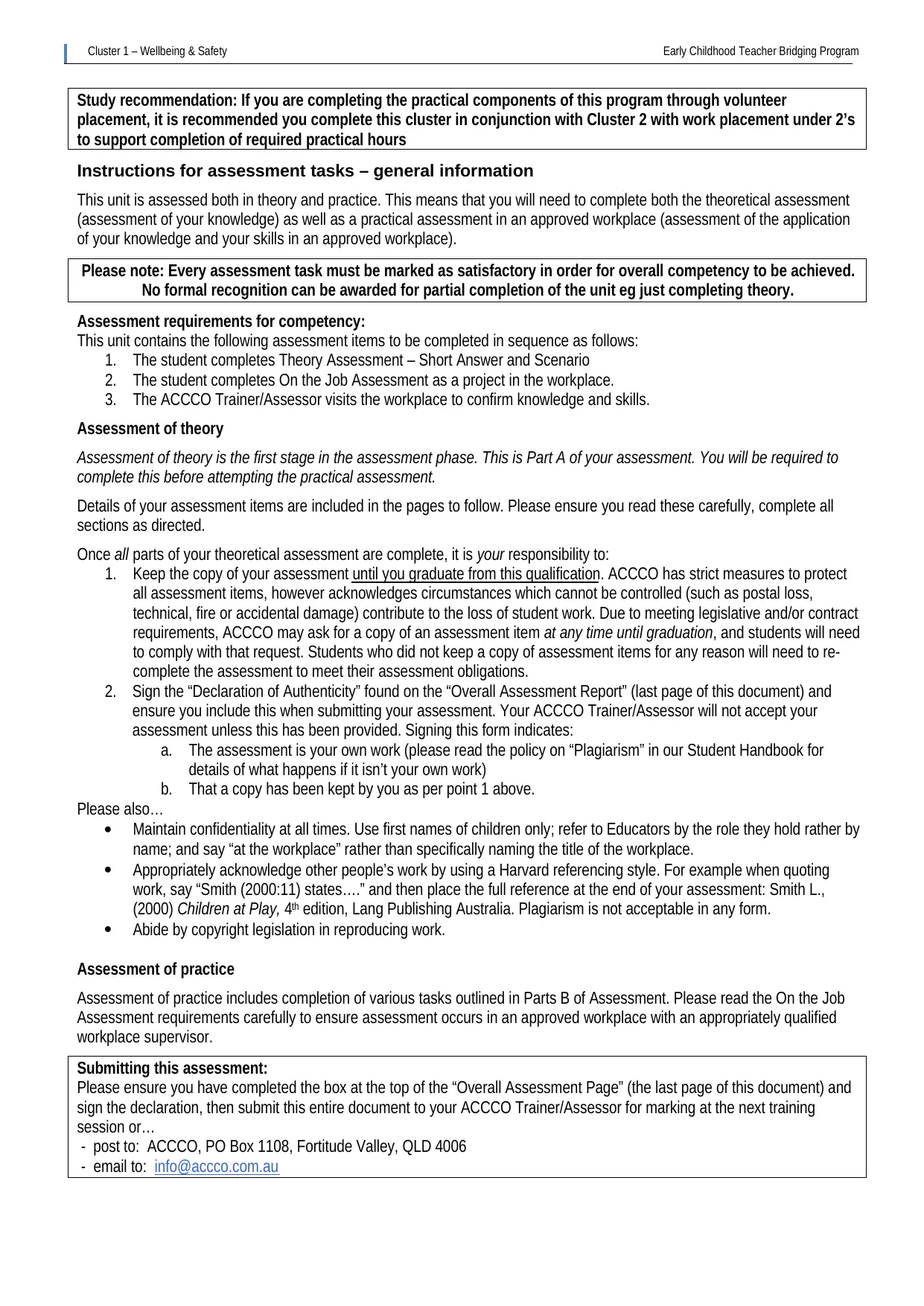
Cluster 1 – Wellbeing & Safety Early Childhood Teacher Bridging Program
Study recommendation: If you are completing the practical components of this program through volunteer
placement, it is recommended you complete this cluster in conjunction with Cluster 2 with work placement under 2’s
to support completion of required practical hours
Instructions for assessment tasks – general information
This unit is assessed both in theory and practice. This means that you will need to complete both the theoretical assessment
(assessment of your knowledge) as well as a practical assessment in an approved workplace (assessment of the application
of your knowledge and your skills in an approved workplace).
Please note: Every assessment task must be marked as satisfactory in order for overall competency to be achieved.
No formal recognition can be awarded for partial completion of the unit eg just completing theory.
Assessment requirements for competency:
This unit contains the following assessment items to be completed in sequence as follows:
1. The student completes Theory Assessment – Short Answer and Scenario
2. The student completes On the Job Assessment as a project in the workplace.
3. The ACCCO Trainer/Assessor visits the workplace to confirm knowledge and skills.
Assessment of theory
Assessment of theory is the first stage in the assessment phase. This is Part A of your assessment. You will be required to
complete this before attempting the practical assessment.
Details of your assessment items are included in the pages to follow. Please ensure you read these carefully, complete all
sections as directed.
Once all parts of your theoretical assessment are complete, it is your responsibility to:
1. Keep the copy of your assessment until you graduate from this qualification. ACCCO has strict measures to protect
all assessment items, however acknowledges circumstances which cannot be controlled (such as postal loss,
technical, fire or accidental damage) contribute to the loss of student work. Due to meeting legislative and/or contract
requirements, ACCCO may ask for a copy of an assessment item at any time until graduation, and students will need
to comply with that request. Students who did not keep a copy of assessment items for any reason will need to re-
complete the assessment to meet their assessment obligations.
2. Sign the “Declaration of Authenticity” found on the “Overall Assessment Report” (last page of this document) and
ensure you include this when submitting your assessment. Your ACCCO Trainer/Assessor will not accept your
assessment unless this has been provided. Signing this form indicates:
a. The assessment is your own work (please read the policy on “Plagiarism” in our Student Handbook for
details of what happens if it isn’t your own work)
b. That a copy has been kept by you as per point 1 above.
Please also…
Maintain confidentiality at all times. Use first names of children only; refer to Educators by the role they hold rather by
name; and say “at the workplace” rather than specifically naming the title of the workplace.
Appropriately acknowledge other people’s work by using a Harvard referencing style. For example when quoting
work, say “Smith (2000:11) states….” and then place the full reference at the end of your assessment: Smith L.,
(2000) Children at Play, 4th edition, Lang Publishing Australia. Plagiarism is not acceptable in any form.
Abide by copyright legislation in reproducing work.
Assessment of practice
Assessment of practice includes completion of various tasks outlined in Parts B of Assessment. Please read the On the Job
Assessment requirements carefully to ensure assessment occurs in an approved workplace with an appropriately qualified
workplace supervisor.
Submitting this assessment:
Please ensure you have completed the box at the top of the “Overall Assessment Page” (the last page of this document) and
sign the declaration, then submit this entire document to your ACCCO Trainer/Assessor for marking at the next training
session or…
- post to: ACCCO, PO Box 1108, Fortitude Valley, QLD 4006
- email to: info@accco.com.au
Study recommendation: If you are completing the practical components of this program through volunteer
placement, it is recommended you complete this cluster in conjunction with Cluster 2 with work placement under 2’s
to support completion of required practical hours
Instructions for assessment tasks – general information
This unit is assessed both in theory and practice. This means that you will need to complete both the theoretical assessment
(assessment of your knowledge) as well as a practical assessment in an approved workplace (assessment of the application
of your knowledge and your skills in an approved workplace).
Please note: Every assessment task must be marked as satisfactory in order for overall competency to be achieved.
No formal recognition can be awarded for partial completion of the unit eg just completing theory.
Assessment requirements for competency:
This unit contains the following assessment items to be completed in sequence as follows:
1. The student completes Theory Assessment – Short Answer and Scenario
2. The student completes On the Job Assessment as a project in the workplace.
3. The ACCCO Trainer/Assessor visits the workplace to confirm knowledge and skills.
Assessment of theory
Assessment of theory is the first stage in the assessment phase. This is Part A of your assessment. You will be required to
complete this before attempting the practical assessment.
Details of your assessment items are included in the pages to follow. Please ensure you read these carefully, complete all
sections as directed.
Once all parts of your theoretical assessment are complete, it is your responsibility to:
1. Keep the copy of your assessment until you graduate from this qualification. ACCCO has strict measures to protect
all assessment items, however acknowledges circumstances which cannot be controlled (such as postal loss,
technical, fire or accidental damage) contribute to the loss of student work. Due to meeting legislative and/or contract
requirements, ACCCO may ask for a copy of an assessment item at any time until graduation, and students will need
to comply with that request. Students who did not keep a copy of assessment items for any reason will need to re-
complete the assessment to meet their assessment obligations.
2. Sign the “Declaration of Authenticity” found on the “Overall Assessment Report” (last page of this document) and
ensure you include this when submitting your assessment. Your ACCCO Trainer/Assessor will not accept your
assessment unless this has been provided. Signing this form indicates:
a. The assessment is your own work (please read the policy on “Plagiarism” in our Student Handbook for
details of what happens if it isn’t your own work)
b. That a copy has been kept by you as per point 1 above.
Please also…
Maintain confidentiality at all times. Use first names of children only; refer to Educators by the role they hold rather by
name; and say “at the workplace” rather than specifically naming the title of the workplace.
Appropriately acknowledge other people’s work by using a Harvard referencing style. For example when quoting
work, say “Smith (2000:11) states….” and then place the full reference at the end of your assessment: Smith L.,
(2000) Children at Play, 4th edition, Lang Publishing Australia. Plagiarism is not acceptable in any form.
Abide by copyright legislation in reproducing work.
Assessment of practice
Assessment of practice includes completion of various tasks outlined in Parts B of Assessment. Please read the On the Job
Assessment requirements carefully to ensure assessment occurs in an approved workplace with an appropriately qualified
workplace supervisor.
Submitting this assessment:
Please ensure you have completed the box at the top of the “Overall Assessment Page” (the last page of this document) and
sign the declaration, then submit this entire document to your ACCCO Trainer/Assessor for marking at the next training
session or…
- post to: ACCCO, PO Box 1108, Fortitude Valley, QLD 4006
- email to: info@accco.com.au

Cluster 1 – Wellbeing & Safety Early Childhood Teacher Bridging Program
The State of Queensland (Department of Education, Training and Employment) Page 4
Version 2.1: April 2014
Please note: ACCCO uses the Learning and Assessment Resources from the Department of Education Training and
Employment for the Early Childhood Teacher Bridging Program (ECTBP). Full acknowledgement is given for
ownership of all material outlined in this document.
ACCCO has adapted the document for delivery purposes only without changing content.
© The State of Queensland (Department of Education, Training and Employment) 2014
The Queensland Government supports and encourages the dissemination and exchange of information. However,
copyright protects this material. The State of Queensland has no objection to this material being reproduced, or made
available offline or electronically, but only if it is recognised as the owner and this material remains unaltered.
Inquiries to adapt this material should be addressed to:
Legal and Administrative Law Branch
Executive Director
Legal and Administrative Law Branch
GPO Box 15033
Brisbane City East Qld 4002
The Early Childhood Teacher Bridging Program is a key strategy within the Queensland 2011–2014 Early Childhood
Education and Care Workforce Action Plan (WAP). A Queensland Government initiative through a partnership with Centre
for Managed Strategies (Department of Education, Training and Employment), Queensland College of Teachers and the
Office of Early Childhood Education and Care.
___________________________________________________________________________________________
Acknowledgements: Alison Ford and Anna Neilsen
Early Childhood Bridging Program Team (2012)
Early Childhood Education and Care Skilling Strategies
Revised and developed by: Michelle Gossow, Project Officer
Early Childhood Teacher Bridging Program Development Team (2013/2014)
Centre for Managed Strategies
Department of Education, Training and Employment; Queensland
___________________________________________________________________________________________
Version control and document history
Document Version Release Date Summary of modifications
1.1 May 2013 Final produced following
assessment validation
2.1 April 2014 Final produced following
assessment validation
In accordance with the Standards for NVR Registered Training Organisations requirements, Standard 15.5 says assessment
‘must be systematically validated’. Therefore it is a requirement for RTOs to ensure that any assessment is validated. For
further details see:
The Australian Skills Quality Authority - http://www.asqa.gov.au/faqs/frequently-asked-questions.html
Providers can stay informed about training package updates by subscribing to updates on training.gov.au.
The State of Queensland (Department of Education, Training and Employment) Page 4
Version 2.1: April 2014
Please note: ACCCO uses the Learning and Assessment Resources from the Department of Education Training and
Employment for the Early Childhood Teacher Bridging Program (ECTBP). Full acknowledgement is given for
ownership of all material outlined in this document.
ACCCO has adapted the document for delivery purposes only without changing content.
© The State of Queensland (Department of Education, Training and Employment) 2014
The Queensland Government supports and encourages the dissemination and exchange of information. However,
copyright protects this material. The State of Queensland has no objection to this material being reproduced, or made
available offline or electronically, but only if it is recognised as the owner and this material remains unaltered.
Inquiries to adapt this material should be addressed to:
Legal and Administrative Law Branch
Executive Director
Legal and Administrative Law Branch
GPO Box 15033
Brisbane City East Qld 4002
The Early Childhood Teacher Bridging Program is a key strategy within the Queensland 2011–2014 Early Childhood
Education and Care Workforce Action Plan (WAP). A Queensland Government initiative through a partnership with Centre
for Managed Strategies (Department of Education, Training and Employment), Queensland College of Teachers and the
Office of Early Childhood Education and Care.
___________________________________________________________________________________________
Acknowledgements: Alison Ford and Anna Neilsen
Early Childhood Bridging Program Team (2012)
Early Childhood Education and Care Skilling Strategies
Revised and developed by: Michelle Gossow, Project Officer
Early Childhood Teacher Bridging Program Development Team (2013/2014)
Centre for Managed Strategies
Department of Education, Training and Employment; Queensland
___________________________________________________________________________________________
Version control and document history
Document Version Release Date Summary of modifications
1.1 May 2013 Final produced following
assessment validation
2.1 April 2014 Final produced following
assessment validation
In accordance with the Standards for NVR Registered Training Organisations requirements, Standard 15.5 says assessment
‘must be systematically validated’. Therefore it is a requirement for RTOs to ensure that any assessment is validated. For
further details see:
The Australian Skills Quality Authority - http://www.asqa.gov.au/faqs/frequently-asked-questions.html
Providers can stay informed about training package updates by subscribing to updates on training.gov.au.
Secure Best Marks with AI Grader
Need help grading? Try our AI Grader for instant feedback on your assignments.
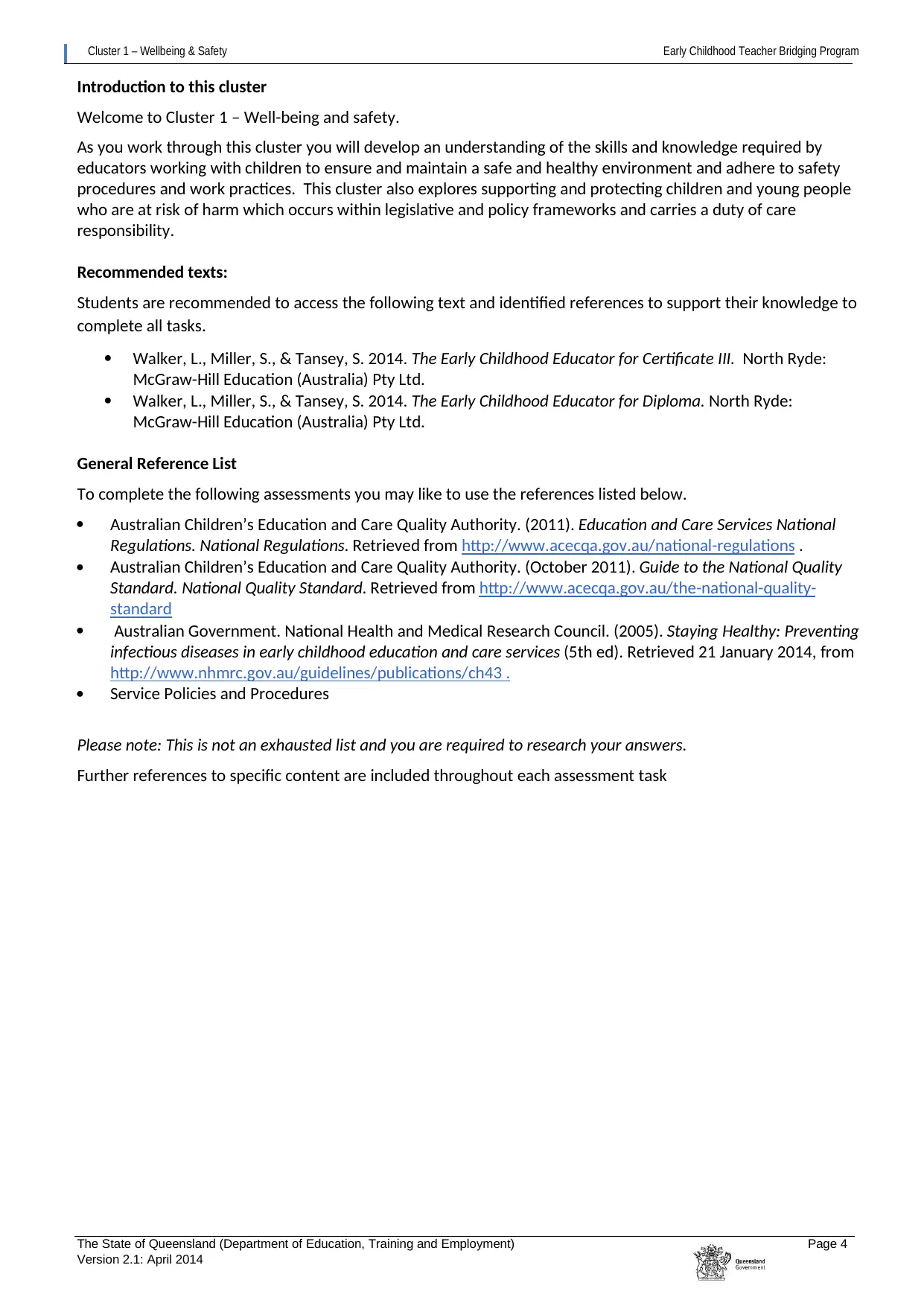
Cluster 1 – Wellbeing & Safety Early Childhood Teacher Bridging Program
The State of Queensland (Department of Education, Training and Employment) Page 4
Version 2.1: April 2014
Introduction to this cluster
Welcome to Cluster 1 – Well-being and safety.
As you work through this cluster you will develop an understanding of the skills and knowledge required by
educators working with children to ensure and maintain a safe and healthy environment and adhere to safety
procedures and work practices. This cluster also explores supporting and protecting children and young people
who are at risk of harm which occurs within legislative and policy frameworks and carries a duty of care
responsibility.
Recommended texts:
Students are recommended to access the following text and identified references to support their knowledge to
complete all tasks.
Walker, L., Miller, S., & Tansey, S. 2014. The Early Childhood Educator for Certificate III. North Ryde:
McGraw-Hill Education (Australia) Pty Ltd.
Walker, L., Miller, S., & Tansey, S. 2014. The Early Childhood Educator for Diploma. North Ryde:
McGraw-Hill Education (Australia) Pty Ltd.
General Reference List
To complete the following assessments you may like to use the references listed below.
Australian Children’s Education and Care Quality Authority. (2011). Education and Care Services National
Regulations. National Regulations. Retrieved from http://www.acecqa.gov.au/national-regulations .
Australian Children’s Education and Care Quality Authority. (October 2011). Guide to the National Quality
Standard. National Quality Standard. Retrieved from http://www.acecqa.gov.au/the-national-quality-
standard
Australian Government. National Health and Medical Research Council. (2005). Staying Healthy: Preventing
infectious diseases in early childhood education and care services (5th ed). Retrieved 21 January 2014, from
http://www.nhmrc.gov.au/guidelines/publications/ch43 .
Service Policies and Procedures
Please note: This is not an exhausted list and you are required to research your answers.
Further references to specific content are included throughout each assessment task
The State of Queensland (Department of Education, Training and Employment) Page 4
Version 2.1: April 2014
Introduction to this cluster
Welcome to Cluster 1 – Well-being and safety.
As you work through this cluster you will develop an understanding of the skills and knowledge required by
educators working with children to ensure and maintain a safe and healthy environment and adhere to safety
procedures and work practices. This cluster also explores supporting and protecting children and young people
who are at risk of harm which occurs within legislative and policy frameworks and carries a duty of care
responsibility.
Recommended texts:
Students are recommended to access the following text and identified references to support their knowledge to
complete all tasks.
Walker, L., Miller, S., & Tansey, S. 2014. The Early Childhood Educator for Certificate III. North Ryde:
McGraw-Hill Education (Australia) Pty Ltd.
Walker, L., Miller, S., & Tansey, S. 2014. The Early Childhood Educator for Diploma. North Ryde:
McGraw-Hill Education (Australia) Pty Ltd.
General Reference List
To complete the following assessments you may like to use the references listed below.
Australian Children’s Education and Care Quality Authority. (2011). Education and Care Services National
Regulations. National Regulations. Retrieved from http://www.acecqa.gov.au/national-regulations .
Australian Children’s Education and Care Quality Authority. (October 2011). Guide to the National Quality
Standard. National Quality Standard. Retrieved from http://www.acecqa.gov.au/the-national-quality-
standard
Australian Government. National Health and Medical Research Council. (2005). Staying Healthy: Preventing
infectious diseases in early childhood education and care services (5th ed). Retrieved 21 January 2014, from
http://www.nhmrc.gov.au/guidelines/publications/ch43 .
Service Policies and Procedures
Please note: This is not an exhausted list and you are required to research your answers.
Further references to specific content are included throughout each assessment task

Cluster 1 – Wellbeing & Safety Early Childhood Teacher Bridging Program
The State of Queensland (Department of Education, Training and Employment) Page 4
Version 2.1: April 2014
Part A of Assessment - Theory
Assessment One: Short Answer Questions & Scenario
Learning Resources:
Australian Government. National Health and Medical Research Council. (2005). Staying Healthy: Preventing
infectious diseases in early childhood education and care services (5th ed). Retrieved 21 January 2014, from
http://www.nhmrc.gov.au/guidelines/publications/ch43 .
Australian Government. National Childcare Accreditation Council. (2009). Factsheet #18 Managing illness in
child care. Factsheet: Long Day Care Factsheets. Retrieved 20 January 2014, from
http://ncac.acecqa.gov.au/educator-resources/factsheets/qias_factsheet_18.pdf
Queensland Government. Queensland Health. (2010). Time out [poster]. Child health – contagious
conditions. Retrieved 28 January 2014, from
http://www.health.qld.gov.au/ph/documents/cdb/timeout_poster.pdf
Part A
Note: When undertaking this task you are required to address the issue within the scope of your role, skills and
knowledge as an early childhood educator.
Scenario: A baby in your service has been unwell for several days. Initially the baby had a runny nose and was
sneezing, which soon developed into bouts of coughing which appeared to be severe. At times, after a bout of
coughing, the baby will vomit or gag.
1. Outline all steps, in order of priority, your service should take to immediately care for this baby and all
other children, families and educators at the service.
This baby has been unwell for several days, when the baby shows signs of vomiting and bouts of coughing we will
ring the caregiver and discuss that this baby needs to be with someone that cares about them and needs to go and see a GP.
The baby has been seperated from the other children as soon as signs of illness started.
Inform your director of the situation to also be involved in the conversation.
We will discuss with the caregiver the babies signs and symptoms and show them the monitoring sheet we have been
recording for this baby. (name, age, room,condition, comments)
Also we have filled out an illness incident report to be given to the caregiver to sign and acknowledge and further their
information of the illness, may also be used at the Doctors to help relay information.
While waiting for the caregiver to arrive we have seperated the baby from the other children in a quiet corner on a mattress
where we can still supervise and the baby is still comfortable.
Discuss with caregiver to let us know what happens at the doctors and to be in touch.
Clean and disinfect the mattress the baby was on and anything they had touched closely.
Clean surfaces with warm and soapy water;
-toys in their mouth
-low shelves
-floors
-door knobs
-surfaces the child had frequent contact with
-beds,stretches, mattresses ect
Wait for a call to see what is happening with baby, discuss the illness and the procedures with the caregiver and director.
The State of Queensland (Department of Education, Training and Employment) Page 4
Version 2.1: April 2014
Part A of Assessment - Theory
Assessment One: Short Answer Questions & Scenario
Learning Resources:
Australian Government. National Health and Medical Research Council. (2005). Staying Healthy: Preventing
infectious diseases in early childhood education and care services (5th ed). Retrieved 21 January 2014, from
http://www.nhmrc.gov.au/guidelines/publications/ch43 .
Australian Government. National Childcare Accreditation Council. (2009). Factsheet #18 Managing illness in
child care. Factsheet: Long Day Care Factsheets. Retrieved 20 January 2014, from
http://ncac.acecqa.gov.au/educator-resources/factsheets/qias_factsheet_18.pdf
Queensland Government. Queensland Health. (2010). Time out [poster]. Child health – contagious
conditions. Retrieved 28 January 2014, from
http://www.health.qld.gov.au/ph/documents/cdb/timeout_poster.pdf
Part A
Note: When undertaking this task you are required to address the issue within the scope of your role, skills and
knowledge as an early childhood educator.
Scenario: A baby in your service has been unwell for several days. Initially the baby had a runny nose and was
sneezing, which soon developed into bouts of coughing which appeared to be severe. At times, after a bout of
coughing, the baby will vomit or gag.
1. Outline all steps, in order of priority, your service should take to immediately care for this baby and all
other children, families and educators at the service.
This baby has been unwell for several days, when the baby shows signs of vomiting and bouts of coughing we will
ring the caregiver and discuss that this baby needs to be with someone that cares about them and needs to go and see a GP.
The baby has been seperated from the other children as soon as signs of illness started.
Inform your director of the situation to also be involved in the conversation.
We will discuss with the caregiver the babies signs and symptoms and show them the monitoring sheet we have been
recording for this baby. (name, age, room,condition, comments)
Also we have filled out an illness incident report to be given to the caregiver to sign and acknowledge and further their
information of the illness, may also be used at the Doctors to help relay information.
While waiting for the caregiver to arrive we have seperated the baby from the other children in a quiet corner on a mattress
where we can still supervise and the baby is still comfortable.
Discuss with caregiver to let us know what happens at the doctors and to be in touch.
Clean and disinfect the mattress the baby was on and anything they had touched closely.
Clean surfaces with warm and soapy water;
-toys in their mouth
-low shelves
-floors
-door knobs
-surfaces the child had frequent contact with
-beds,stretches, mattresses ect
Wait for a call to see what is happening with baby, discuss the illness and the procedures with the caregiver and director.
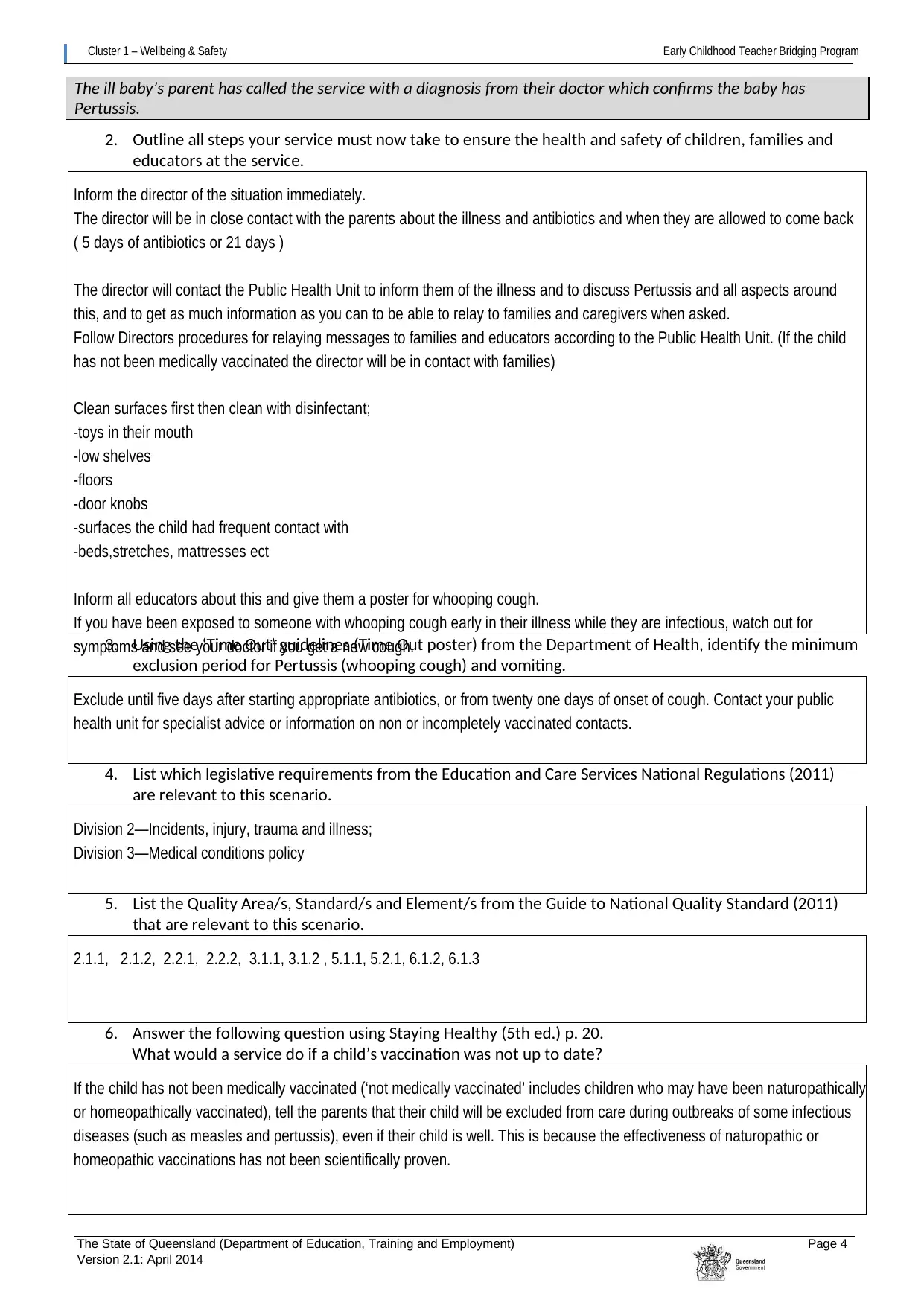
Cluster 1 – Wellbeing & Safety Early Childhood Teacher Bridging Program
The State of Queensland (Department of Education, Training and Employment) Page 4
Version 2.1: April 2014
The ill baby’s parent has called the service with a diagnosis from their doctor which confirms the baby has
Pertussis.
2. Outline all steps your service must now take to ensure the health and safety of children, families and
educators at the service.
3. Using the ‘Time Out’ guidelines (Time Out poster) from the Department of Health, identify the minimum
exclusion period for Pertussis (whooping cough) and vomiting.
4. List which legislative requirements from the Education and Care Services National Regulations (2011)
are relevant to this scenario.
5. List the Quality Area/s, Standard/s and Element/s from the Guide to National Quality Standard (2011)
that are relevant to this scenario.
6. Answer the following question using Staying Healthy (5th ed.) p. 20.
What would a service do if a child’s vaccination was not up to date?
Inform the director of the situation immediately.
The director will be in close contact with the parents about the illness and antibiotics and when they are allowed to come back
( 5 days of antibiotics or 21 days )
The director will contact the Public Health Unit to inform them of the illness and to discuss Pertussis and all aspects around
this, and to get as much information as you can to be able to relay to families and caregivers when asked.
Follow Directors procedures for relaying messages to families and educators according to the Public Health Unit. (If the child
has not been medically vaccinated the director will be in contact with families)
Clean surfaces first then clean with disinfectant;
-toys in their mouth
-low shelves
-floors
-door knobs
-surfaces the child had frequent contact with
-beds,stretches, mattresses ect
Inform all educators about this and give them a poster for whooping cough.
If you have been exposed to someone with whooping cough early in their illness while they are infectious, watch out for
symptoms and see your doctor if you get a new cough.
Exclude until five days after starting appropriate antibiotics, or from twenty one days of onset of cough. Contact your public
health unit for specialist advice or information on non or incompletely vaccinated contacts.
Division 2—Incidents, injury, trauma and illness;
Division 3—Medical conditions policy
2.1.1, 2.1.2, 2.2.1, 2.2.2, 3.1.1, 3.1.2 , 5.1.1, 5.2.1, 6.1.2, 6.1.3
If the child has not been medically vaccinated (‘not medically vaccinated’ includes children who may have been naturopathically
or homeopathically vaccinated), tell the parents that their child will be excluded from care during outbreaks of some infectious
diseases (such as measles and pertussis), even if their child is well. This is because the effectiveness of naturopathic or
homeopathic vaccinations has not been scientifically proven.
The State of Queensland (Department of Education, Training and Employment) Page 4
Version 2.1: April 2014
The ill baby’s parent has called the service with a diagnosis from their doctor which confirms the baby has
Pertussis.
2. Outline all steps your service must now take to ensure the health and safety of children, families and
educators at the service.
3. Using the ‘Time Out’ guidelines (Time Out poster) from the Department of Health, identify the minimum
exclusion period for Pertussis (whooping cough) and vomiting.
4. List which legislative requirements from the Education and Care Services National Regulations (2011)
are relevant to this scenario.
5. List the Quality Area/s, Standard/s and Element/s from the Guide to National Quality Standard (2011)
that are relevant to this scenario.
6. Answer the following question using Staying Healthy (5th ed.) p. 20.
What would a service do if a child’s vaccination was not up to date?
Inform the director of the situation immediately.
The director will be in close contact with the parents about the illness and antibiotics and when they are allowed to come back
( 5 days of antibiotics or 21 days )
The director will contact the Public Health Unit to inform them of the illness and to discuss Pertussis and all aspects around
this, and to get as much information as you can to be able to relay to families and caregivers when asked.
Follow Directors procedures for relaying messages to families and educators according to the Public Health Unit. (If the child
has not been medically vaccinated the director will be in contact with families)
Clean surfaces first then clean with disinfectant;
-toys in their mouth
-low shelves
-floors
-door knobs
-surfaces the child had frequent contact with
-beds,stretches, mattresses ect
Inform all educators about this and give them a poster for whooping cough.
If you have been exposed to someone with whooping cough early in their illness while they are infectious, watch out for
symptoms and see your doctor if you get a new cough.
Exclude until five days after starting appropriate antibiotics, or from twenty one days of onset of cough. Contact your public
health unit for specialist advice or information on non or incompletely vaccinated contacts.
Division 2—Incidents, injury, trauma and illness;
Division 3—Medical conditions policy
2.1.1, 2.1.2, 2.2.1, 2.2.2, 3.1.1, 3.1.2 , 5.1.1, 5.2.1, 6.1.2, 6.1.3
If the child has not been medically vaccinated (‘not medically vaccinated’ includes children who may have been naturopathically
or homeopathically vaccinated), tell the parents that their child will be excluded from care during outbreaks of some infectious
diseases (such as measles and pertussis), even if their child is well. This is because the effectiveness of naturopathic or
homeopathic vaccinations has not been scientifically proven.
Paraphrase This Document
Need a fresh take? Get an instant paraphrase of this document with our AI Paraphraser
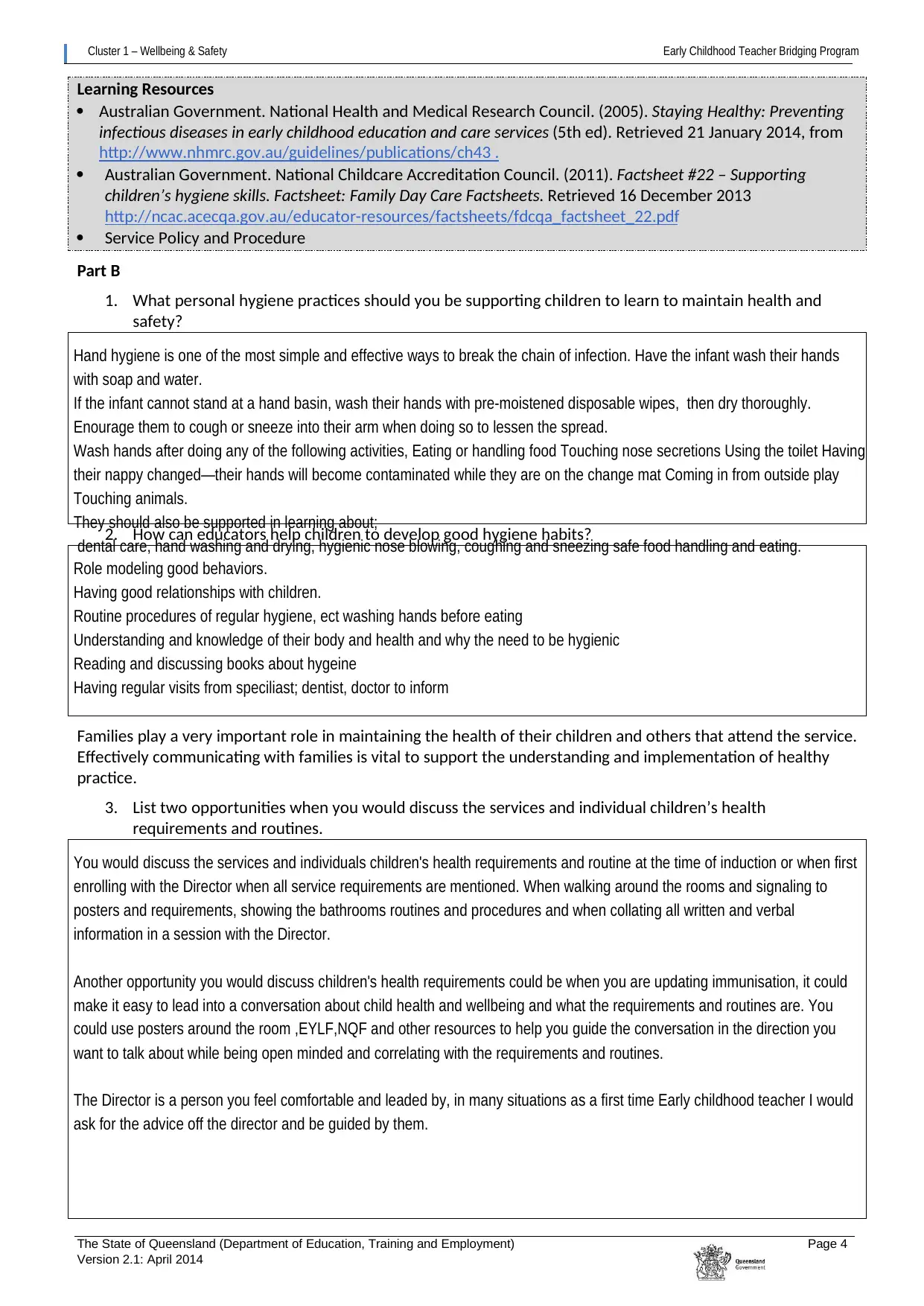
Cluster 1 – Wellbeing & Safety Early Childhood Teacher Bridging Program
The State of Queensland (Department of Education, Training and Employment) Page 4
Version 2.1: April 2014
Learning Resources
Australian Government. National Health and Medical Research Council. (2005). Staying Healthy: Preventing
infectious diseases in early childhood education and care services (5th ed). Retrieved 21 January 2014, from
http://www.nhmrc.gov.au/guidelines/publications/ch43 .
Australian Government. National Childcare Accreditation Council. (2011). Factsheet #22 – Supporting
children’s hygiene skills. Factsheet: Family Day Care Factsheets. Retrieved 16 December 2013
http://ncac.acecqa.gov.au/educator-resources/factsheets/fdcqa_factsheet_22.pdf
Service Policy and Procedure
Part B
1. What personal hygiene practices should you be supporting children to learn to maintain health and
safety?
2. How can educators help children to develop good hygiene habits?
Families play a very important role in maintaining the health of their children and others that attend the service.
Effectively communicating with families is vital to support the understanding and implementation of healthy
practice.
3. List two opportunities when you would discuss the services and individual children’s health
requirements and routines.
Hand hygiene is one of the most simple and effective ways to break the chain of infection. Have the infant wash their hands
with soap and water.
If the infant cannot stand at a hand basin, wash their hands with pre-moistened disposable wipes, then dry thoroughly.
Enourage them to cough or sneeze into their arm when doing so to lessen the spread.
Wash hands after doing any of the following activities, Eating or handling food Touching nose secretions Using the toilet Having
their nappy changed—their hands will become contaminated while they are on the change mat Coming in from outside play
Touching animals.
They should also be supported in learning about;
dental care, hand washing and drying, hygienic nose blowing, coughing and sneezing safe food handling and eating.
Role modeling good behaviors.
Having good relationships with children.
Routine procedures of regular hygiene, ect washing hands before eating
Understanding and knowledge of their body and health and why the need to be hygienic
Reading and discussing books about hygeine
Having regular visits from speciliast; dentist, doctor to inform
You would discuss the services and individuals children's health requirements and routine at the time of induction or when first
enrolling with the Director when all service requirements are mentioned. When walking around the rooms and signaling to
posters and requirements, showing the bathrooms routines and procedures and when collating all written and verbal
information in a session with the Director.
Another opportunity you would discuss children's health requirements could be when you are updating immunisation, it could
make it easy to lead into a conversation about child health and wellbeing and what the requirements and routines are. You
could use posters around the room ,EYLF,NQF and other resources to help you guide the conversation in the direction you
want to talk about while being open minded and correlating with the requirements and routines.
The Director is a person you feel comfortable and leaded by, in many situations as a first time Early childhood teacher I would
ask for the advice off the director and be guided by them.
The State of Queensland (Department of Education, Training and Employment) Page 4
Version 2.1: April 2014
Learning Resources
Australian Government. National Health and Medical Research Council. (2005). Staying Healthy: Preventing
infectious diseases in early childhood education and care services (5th ed). Retrieved 21 January 2014, from
http://www.nhmrc.gov.au/guidelines/publications/ch43 .
Australian Government. National Childcare Accreditation Council. (2011). Factsheet #22 – Supporting
children’s hygiene skills. Factsheet: Family Day Care Factsheets. Retrieved 16 December 2013
http://ncac.acecqa.gov.au/educator-resources/factsheets/fdcqa_factsheet_22.pdf
Service Policy and Procedure
Part B
1. What personal hygiene practices should you be supporting children to learn to maintain health and
safety?
2. How can educators help children to develop good hygiene habits?
Families play a very important role in maintaining the health of their children and others that attend the service.
Effectively communicating with families is vital to support the understanding and implementation of healthy
practice.
3. List two opportunities when you would discuss the services and individual children’s health
requirements and routines.
Hand hygiene is one of the most simple and effective ways to break the chain of infection. Have the infant wash their hands
with soap and water.
If the infant cannot stand at a hand basin, wash their hands with pre-moistened disposable wipes, then dry thoroughly.
Enourage them to cough or sneeze into their arm when doing so to lessen the spread.
Wash hands after doing any of the following activities, Eating or handling food Touching nose secretions Using the toilet Having
their nappy changed—their hands will become contaminated while they are on the change mat Coming in from outside play
Touching animals.
They should also be supported in learning about;
dental care, hand washing and drying, hygienic nose blowing, coughing and sneezing safe food handling and eating.
Role modeling good behaviors.
Having good relationships with children.
Routine procedures of regular hygiene, ect washing hands before eating
Understanding and knowledge of their body and health and why the need to be hygienic
Reading and discussing books about hygeine
Having regular visits from speciliast; dentist, doctor to inform
You would discuss the services and individuals children's health requirements and routine at the time of induction or when first
enrolling with the Director when all service requirements are mentioned. When walking around the rooms and signaling to
posters and requirements, showing the bathrooms routines and procedures and when collating all written and verbal
information in a session with the Director.
Another opportunity you would discuss children's health requirements could be when you are updating immunisation, it could
make it easy to lead into a conversation about child health and wellbeing and what the requirements and routines are. You
could use posters around the room ,EYLF,NQF and other resources to help you guide the conversation in the direction you
want to talk about while being open minded and correlating with the requirements and routines.
The Director is a person you feel comfortable and leaded by, in many situations as a first time Early childhood teacher I would
ask for the advice off the director and be guided by them.
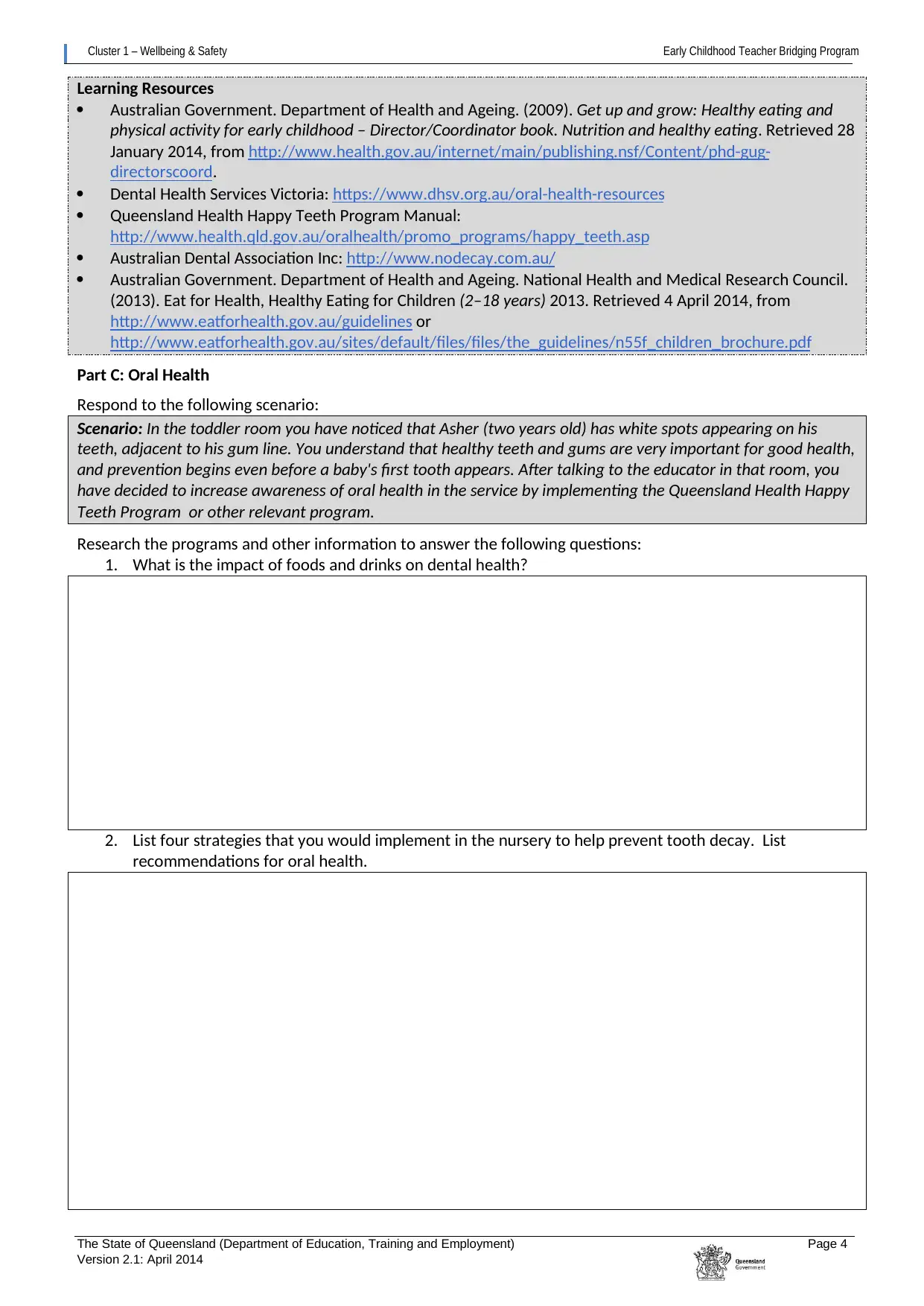
Cluster 1 – Wellbeing & Safety Early Childhood Teacher Bridging Program
The State of Queensland (Department of Education, Training and Employment) Page 4
Version 2.1: April 2014
Learning Resources
Australian Government. Department of Health and Ageing. (2009). Get up and grow: Healthy eating and
physical activity for early childhood – Director/Coordinator book. Nutrition and healthy eating. Retrieved 28
January 2014, from http://www.health.gov.au/internet/main/publishing.nsf/Content/phd-gug-
directorscoord.
Dental Health Services Victoria: https://www.dhsv.org.au/oral-health-resources
Queensland Health Happy Teeth Program Manual:
http://www.health.qld.gov.au/oralhealth/promo_programs/happy_teeth.asp
Australian Dental Association Inc: http://www.nodecay.com.au/
Australian Government. Department of Health and Ageing. National Health and Medical Research Council.
(2013). Eat for Health, Healthy Eating for Children (2–18 years) 2013. Retrieved 4 April 2014, from
http://www.eatforhealth.gov.au/guidelines or
http://www.eatforhealth.gov.au/sites/default/files/files/the_guidelines/n55f_children_brochure.pdf
Part C: Oral Health
Respond to the following scenario:
Scenario: In the toddler room you have noticed that Asher (two years old) has white spots appearing on his
teeth, adjacent to his gum line. You understand that healthy teeth and gums are very important for good health,
and prevention begins even before a baby's first tooth appears. After talking to the educator in that room, you
have decided to increase awareness of oral health in the service by implementing the Queensland Health Happy
Teeth Program or other relevant program.
Research the programs and other information to answer the following questions:
1. What is the impact of foods and drinks on dental health?
2. List four strategies that you would implement in the nursery to help prevent tooth decay. List
recommendations for oral health.
The State of Queensland (Department of Education, Training and Employment) Page 4
Version 2.1: April 2014
Learning Resources
Australian Government. Department of Health and Ageing. (2009). Get up and grow: Healthy eating and
physical activity for early childhood – Director/Coordinator book. Nutrition and healthy eating. Retrieved 28
January 2014, from http://www.health.gov.au/internet/main/publishing.nsf/Content/phd-gug-
directorscoord.
Dental Health Services Victoria: https://www.dhsv.org.au/oral-health-resources
Queensland Health Happy Teeth Program Manual:
http://www.health.qld.gov.au/oralhealth/promo_programs/happy_teeth.asp
Australian Dental Association Inc: http://www.nodecay.com.au/
Australian Government. Department of Health and Ageing. National Health and Medical Research Council.
(2013). Eat for Health, Healthy Eating for Children (2–18 years) 2013. Retrieved 4 April 2014, from
http://www.eatforhealth.gov.au/guidelines or
http://www.eatforhealth.gov.au/sites/default/files/files/the_guidelines/n55f_children_brochure.pdf
Part C: Oral Health
Respond to the following scenario:
Scenario: In the toddler room you have noticed that Asher (two years old) has white spots appearing on his
teeth, adjacent to his gum line. You understand that healthy teeth and gums are very important for good health,
and prevention begins even before a baby's first tooth appears. After talking to the educator in that room, you
have decided to increase awareness of oral health in the service by implementing the Queensland Health Happy
Teeth Program or other relevant program.
Research the programs and other information to answer the following questions:
1. What is the impact of foods and drinks on dental health?
2. List four strategies that you would implement in the nursery to help prevent tooth decay. List
recommendations for oral health.
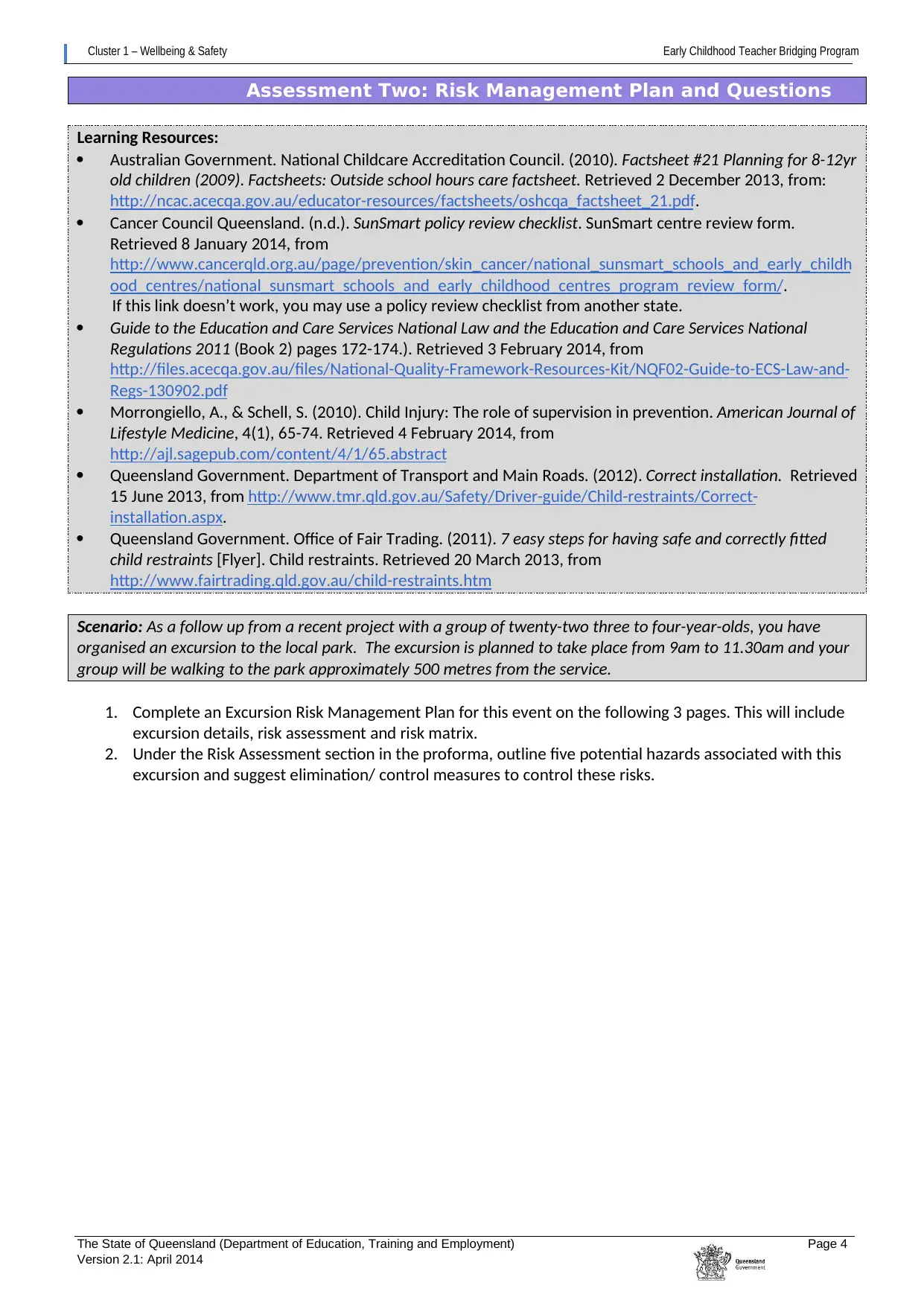
Cluster 1 – Wellbeing & Safety Early Childhood Teacher Bridging Program
The State of Queensland (Department of Education, Training and Employment) Page 4
Version 2.1: April 2014
Assessment Two: Risk Management Plan and Questions
Learning Resources:
Australian Government. National Childcare Accreditation Council. (2010). Factsheet #21 Planning for 8-12yr
old children (2009). Factsheets: Outside school hours care factsheet. Retrieved 2 December 2013, from:
http://ncac.acecqa.gov.au/educator-resources/factsheets/oshcqa_factsheet_21.pdf.
Cancer Council Queensland. (n.d.). SunSmart policy review checklist. SunSmart centre review form.
Retrieved 8 January 2014, from
http://www.cancerqld.org.au/page/prevention/skin_cancer/national_sunsmart_schools_and_early_childh
ood_centres/national_sunsmart_schools_and_early_childhood_centres_program_review_form/.
If this link doesn’t work, you may use a policy review checklist from another state.
Guide to the Education and Care Services National Law and the Education and Care Services National
Regulations 2011 (Book 2) pages 172-174.). Retrieved 3 February 2014, from
http://files.acecqa.gov.au/files/National-Quality-Framework-Resources-Kit/NQF02-Guide-to-ECS-Law-and-
Regs-130902.pdf
Morrongiello, A., & Schell, S. (2010). Child Injury: The role of supervision in prevention. American Journal of
Lifestyle Medicine, 4(1), 65-74. Retrieved 4 February 2014, from
http://ajl.sagepub.com/content/4/1/65.abstract
Queensland Government. Department of Transport and Main Roads. (2012). Correct installation. Retrieved
15 June 2013, from http://www.tmr.qld.gov.au/Safety/Driver-guide/Child-restraints/Correct-
installation.aspx.
Queensland Government. Office of Fair Trading. (2011). 7 easy steps for having safe and correctly fitted
child restraints [Flyer]. Child restraints. Retrieved 20 March 2013, from
http://www.fairtrading.qld.gov.au/child-restraints.htm
Scenario: As a follow up from a recent project with a group of twenty-two three to four-year-olds, you have
organised an excursion to the local park. The excursion is planned to take place from 9am to 11.30am and your
group will be walking to the park approximately 500 metres from the service.
1. Complete an Excursion Risk Management Plan for this event on the following 3 pages. This will include
excursion details, risk assessment and risk matrix.
2. Under the Risk Assessment section in the proforma, outline five potential hazards associated with this
excursion and suggest elimination/ control measures to control these risks.
The State of Queensland (Department of Education, Training and Employment) Page 4
Version 2.1: April 2014
Assessment Two: Risk Management Plan and Questions
Learning Resources:
Australian Government. National Childcare Accreditation Council. (2010). Factsheet #21 Planning for 8-12yr
old children (2009). Factsheets: Outside school hours care factsheet. Retrieved 2 December 2013, from:
http://ncac.acecqa.gov.au/educator-resources/factsheets/oshcqa_factsheet_21.pdf.
Cancer Council Queensland. (n.d.). SunSmart policy review checklist. SunSmart centre review form.
Retrieved 8 January 2014, from
http://www.cancerqld.org.au/page/prevention/skin_cancer/national_sunsmart_schools_and_early_childh
ood_centres/national_sunsmart_schools_and_early_childhood_centres_program_review_form/.
If this link doesn’t work, you may use a policy review checklist from another state.
Guide to the Education and Care Services National Law and the Education and Care Services National
Regulations 2011 (Book 2) pages 172-174.). Retrieved 3 February 2014, from
http://files.acecqa.gov.au/files/National-Quality-Framework-Resources-Kit/NQF02-Guide-to-ECS-Law-and-
Regs-130902.pdf
Morrongiello, A., & Schell, S. (2010). Child Injury: The role of supervision in prevention. American Journal of
Lifestyle Medicine, 4(1), 65-74. Retrieved 4 February 2014, from
http://ajl.sagepub.com/content/4/1/65.abstract
Queensland Government. Department of Transport and Main Roads. (2012). Correct installation. Retrieved
15 June 2013, from http://www.tmr.qld.gov.au/Safety/Driver-guide/Child-restraints/Correct-
installation.aspx.
Queensland Government. Office of Fair Trading. (2011). 7 easy steps for having safe and correctly fitted
child restraints [Flyer]. Child restraints. Retrieved 20 March 2013, from
http://www.fairtrading.qld.gov.au/child-restraints.htm
Scenario: As a follow up from a recent project with a group of twenty-two three to four-year-olds, you have
organised an excursion to the local park. The excursion is planned to take place from 9am to 11.30am and your
group will be walking to the park approximately 500 metres from the service.
1. Complete an Excursion Risk Management Plan for this event on the following 3 pages. This will include
excursion details, risk assessment and risk matrix.
2. Under the Risk Assessment section in the proforma, outline five potential hazards associated with this
excursion and suggest elimination/ control measures to control these risks.
Secure Best Marks with AI Grader
Need help grading? Try our AI Grader for instant feedback on your assignments.
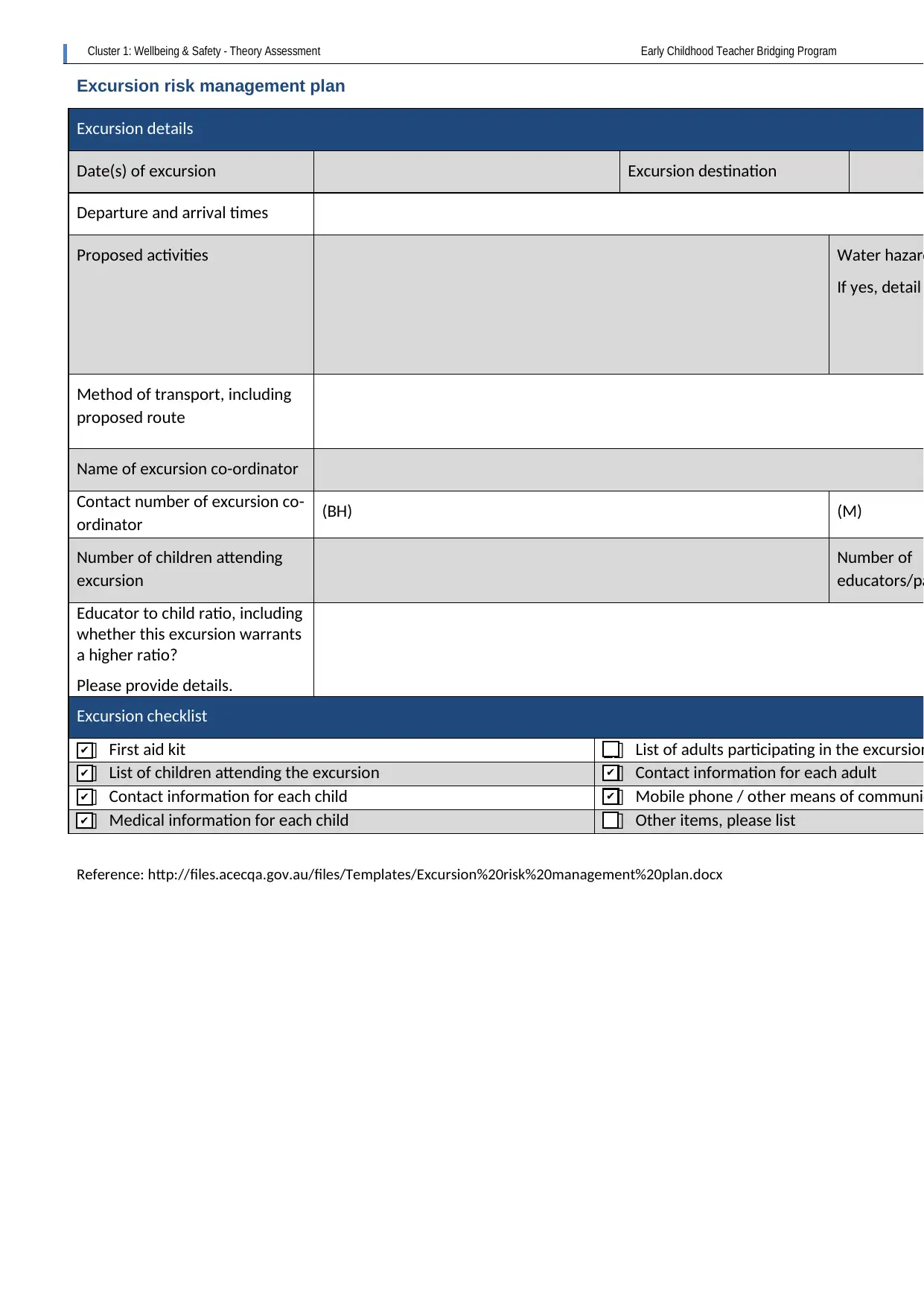
Cluster 1: Wellbeing & Safety - Theory Assessment Early Childhood Teacher Bridging Program
Reference: http://files.acecqa.gov.au/files/Templates/Excursion%20risk%20management%20plan.docx
Excursion risk management plan
Excursion details
Date(s) of excursion Excursion destination
Departure and arrival times
Proposed activities Water hazard
If yes, detail
Method of transport, including
proposed route
Name of excursion co-ordinator
Contact number of excursion co-
ordinator (BH) (M)
Number of children attending
excursion
Number of
educators/pa
Educator to child ratio, including
whether this excursion warrants
a higher ratio?
Please provide details.
Excursion checklist
First aid kit List of adults participating in the excursion
List of children attending the excursion Contact information for each adult
Contact information for each child Mobile phone / other means of communic
Medical information for each child Other items, please list
✔
✔
✔✔
✔
✔
Reference: http://files.acecqa.gov.au/files/Templates/Excursion%20risk%20management%20plan.docx
Excursion risk management plan
Excursion details
Date(s) of excursion Excursion destination
Departure and arrival times
Proposed activities Water hazard
If yes, detail
Method of transport, including
proposed route
Name of excursion co-ordinator
Contact number of excursion co-
ordinator (BH) (M)
Number of children attending
excursion
Number of
educators/pa
Educator to child ratio, including
whether this excursion warrants
a higher ratio?
Please provide details.
Excursion checklist
First aid kit List of adults participating in the excursion
List of children attending the excursion Contact information for each adult
Contact information for each child Mobile phone / other means of communic
Medical information for each child Other items, please list
✔
✔
✔✔
✔
✔
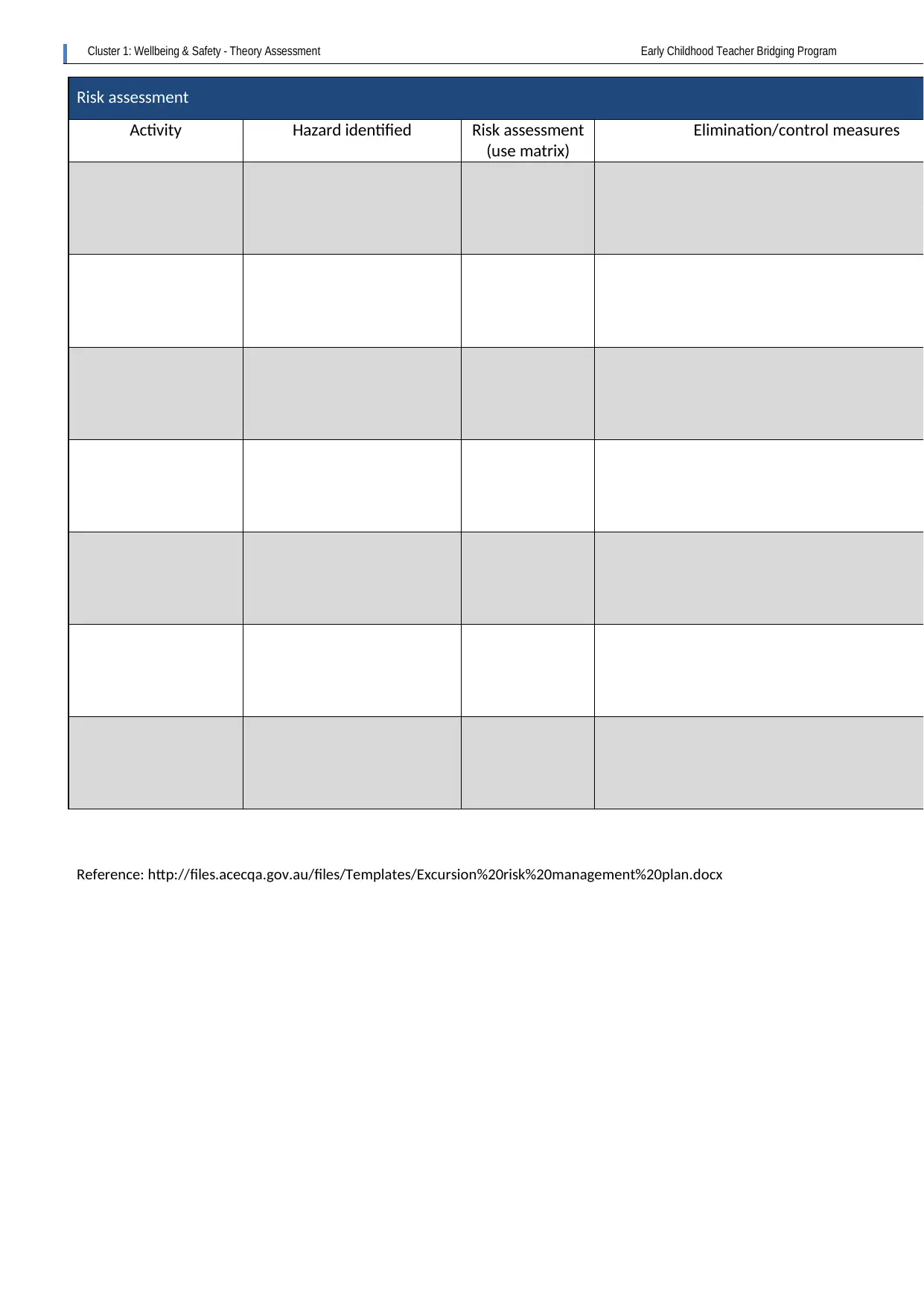
Cluster 1: Wellbeing & Safety - Theory Assessment Early Childhood Teacher Bridging Program
Reference: http://files.acecqa.gov.au/files/Templates/Excursion%20risk%20management%20plan.docx
Risk assessment
Activity Hazard identified Risk assessment
(use matrix)
Elimination/control measures
Reference: http://files.acecqa.gov.au/files/Templates/Excursion%20risk%20management%20plan.docx
Risk assessment
Activity Hazard identified Risk assessment
(use matrix)
Elimination/control measures
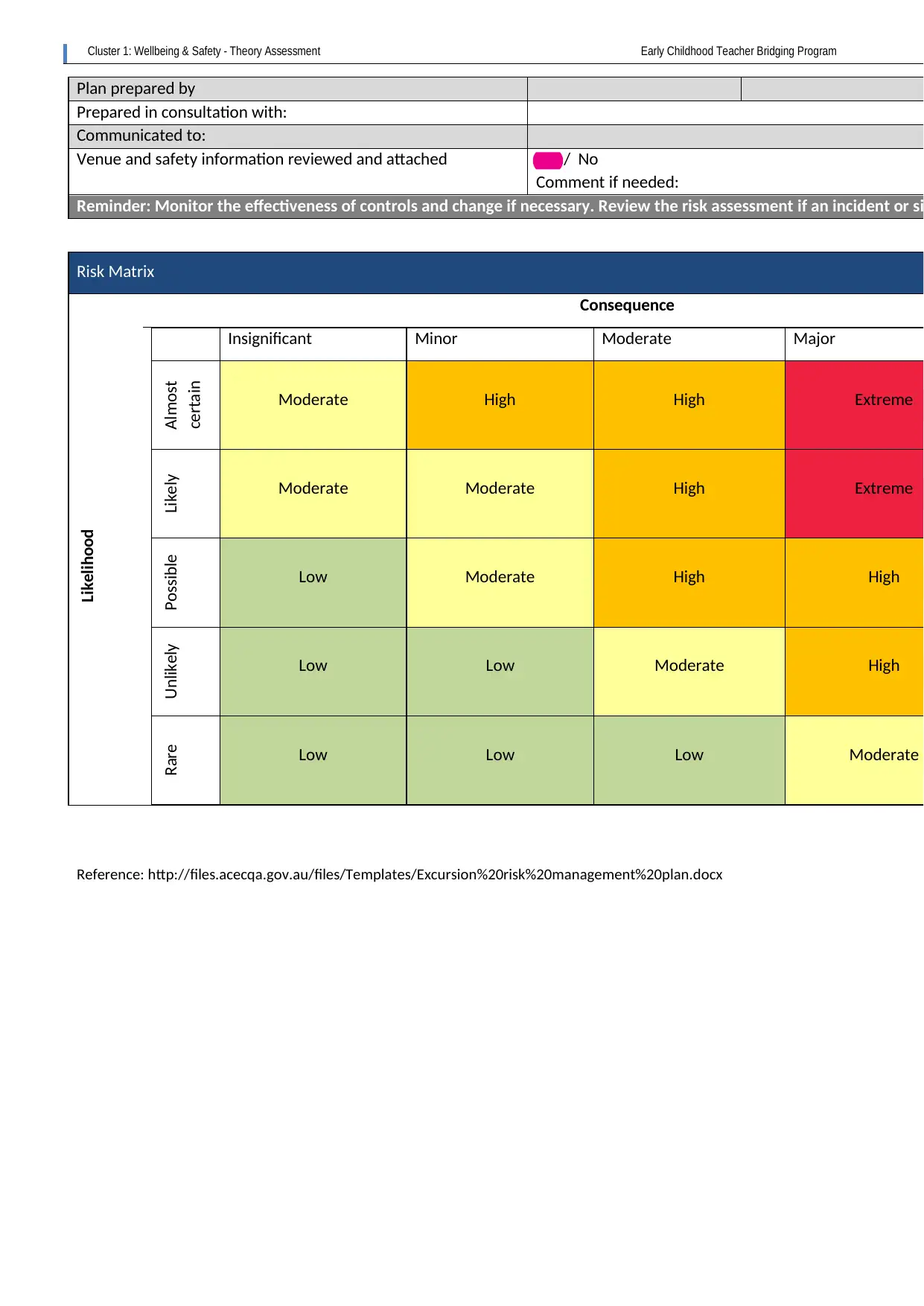
Cluster 1: Wellbeing & Safety - Theory Assessment Early Childhood Teacher Bridging Program
Reference: http://files.acecqa.gov.au/files/Templates/Excursion%20risk%20management%20plan.docx
Plan prepared by
Prepared in consultation with:
Communicated to:
Venue and safety information reviewed and attached Yes / No
Comment if needed:
Reminder: Monitor the effectiveness of controls and change if necessary. Review the risk assessment if an incident or si
Risk Matrix
Consequence
Likelihood
Insignificant Minor Moderate Major
Almost
certain
Moderate High High Extreme
Likely
Moderate Moderate High Extreme
Possible
Low Moderate High High
Unlikely
Low Low Moderate High
Rare Low Low Low Moderate
Reference: http://files.acecqa.gov.au/files/Templates/Excursion%20risk%20management%20plan.docx
Plan prepared by
Prepared in consultation with:
Communicated to:
Venue and safety information reviewed and attached Yes / No
Comment if needed:
Reminder: Monitor the effectiveness of controls and change if necessary. Review the risk assessment if an incident or si
Risk Matrix
Consequence
Likelihood
Insignificant Minor Moderate Major
Almost
certain
Moderate High High Extreme
Likely
Moderate Moderate High Extreme
Possible
Low Moderate High High
Unlikely
Low Low Moderate High
Rare Low Low Low Moderate
Paraphrase This Document
Need a fresh take? Get an instant paraphrase of this document with our AI Paraphraser
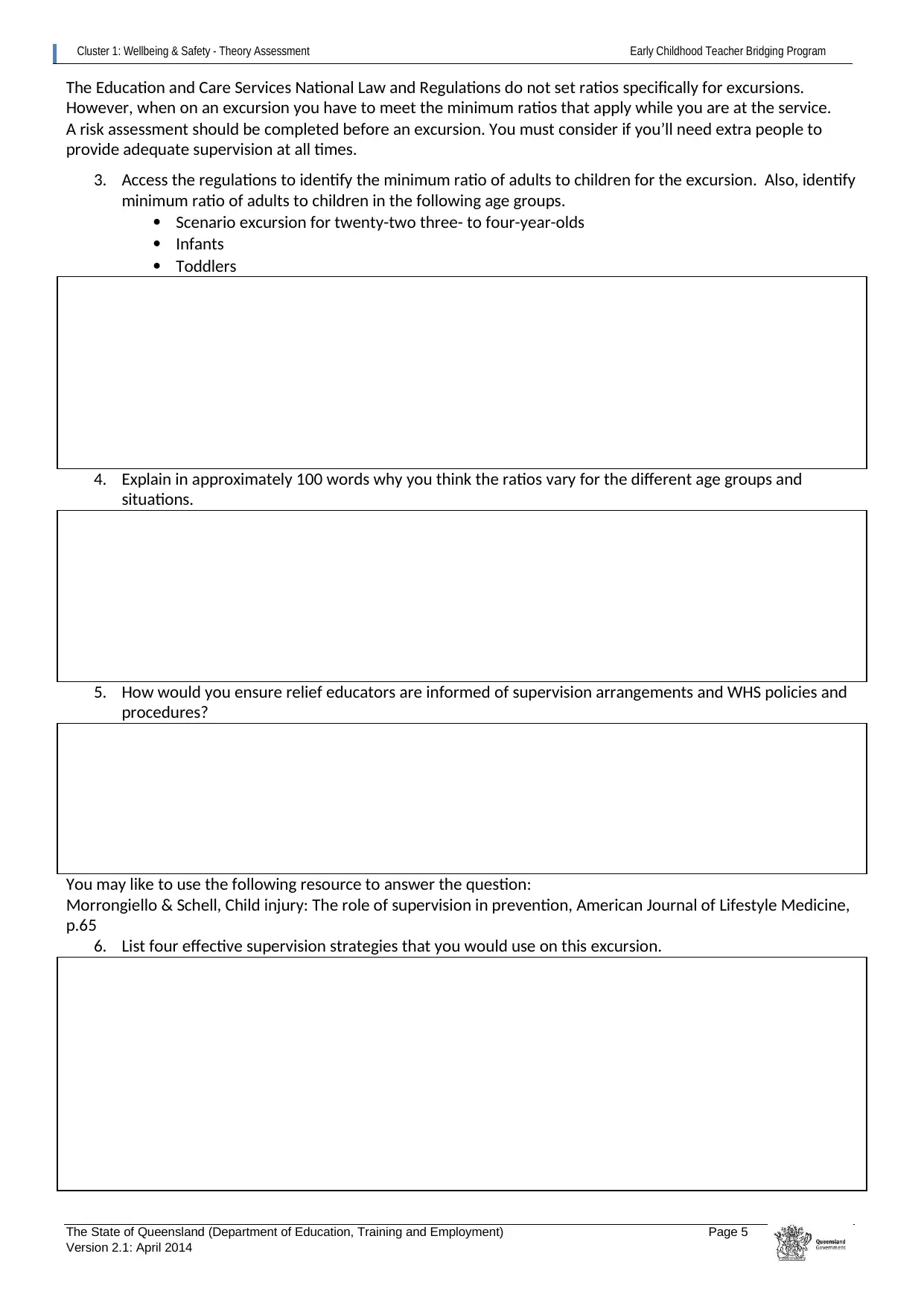
Cluster 1: Wellbeing & Safety - Theory Assessment Early Childhood Teacher Bridging Program
The State of Queensland (Department of Education, Training and Employment) Page 5
Version 2.1: April 2014
The Education and Care Services National Law and Regulations do not set ratios specifically for excursions.
However, when on an excursion you have to meet the minimum ratios that apply while you are at the service.
A risk assessment should be completed before an excursion. You must consider if you’ll need extra people to
provide adequate supervision at all times.
3. Access the regulations to identify the minimum ratio of adults to children for the excursion. Also, identify
minimum ratio of adults to children in the following age groups.
Scenario excursion for twenty-two three- to four-year-olds
Infants
Toddlers
4. Explain in approximately 100 words why you think the ratios vary for the different age groups and
situations.
5. How would you ensure relief educators are informed of supervision arrangements and WHS policies and
procedures?
You may like to use the following resource to answer the question:
Morrongiello & Schell, Child injury: The role of supervision in prevention, American Journal of Lifestyle Medicine,
p.65
6. List four effective supervision strategies that you would use on this excursion.
The State of Queensland (Department of Education, Training and Employment) Page 5
Version 2.1: April 2014
The Education and Care Services National Law and Regulations do not set ratios specifically for excursions.
However, when on an excursion you have to meet the minimum ratios that apply while you are at the service.
A risk assessment should be completed before an excursion. You must consider if you’ll need extra people to
provide adequate supervision at all times.
3. Access the regulations to identify the minimum ratio of adults to children for the excursion. Also, identify
minimum ratio of adults to children in the following age groups.
Scenario excursion for twenty-two three- to four-year-olds
Infants
Toddlers
4. Explain in approximately 100 words why you think the ratios vary for the different age groups and
situations.
5. How would you ensure relief educators are informed of supervision arrangements and WHS policies and
procedures?
You may like to use the following resource to answer the question:
Morrongiello & Schell, Child injury: The role of supervision in prevention, American Journal of Lifestyle Medicine,
p.65
6. List four effective supervision strategies that you would use on this excursion.
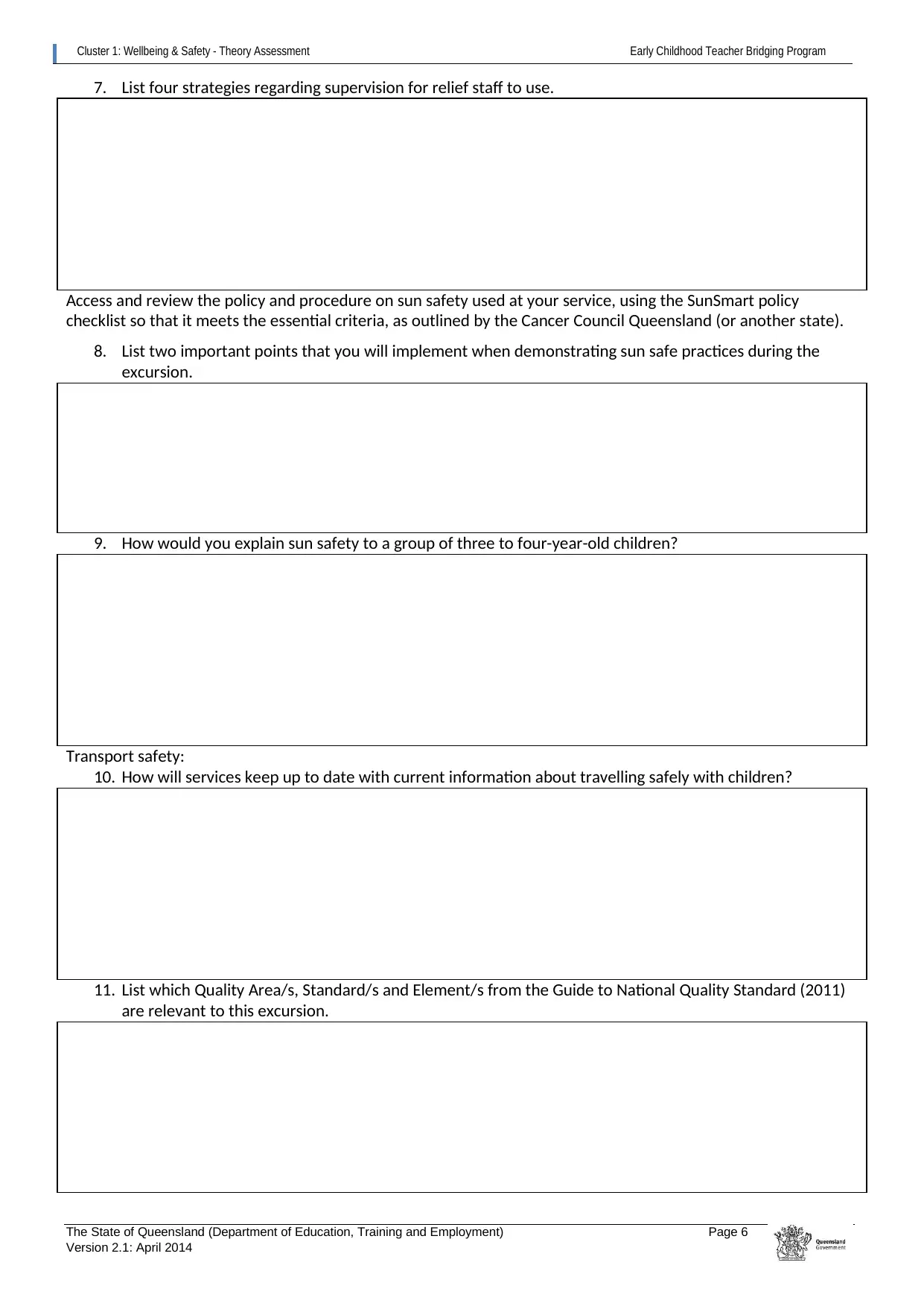
Cluster 1: Wellbeing & Safety - Theory Assessment Early Childhood Teacher Bridging Program
The State of Queensland (Department of Education, Training and Employment) Page 6
Version 2.1: April 2014
7. List four strategies regarding supervision for relief staff to use.
Access and review the policy and procedure on sun safety used at your service, using the SunSmart policy
checklist so that it meets the essential criteria, as outlined by the Cancer Council Queensland (or another state).
8. List two important points that you will implement when demonstrating sun safe practices during the
excursion.
9. How would you explain sun safety to a group of three to four-year-old children?
Transport safety:
10. How will services keep up to date with current information about travelling safely with children?
11. List which Quality Area/s, Standard/s and Element/s from the Guide to National Quality Standard (2011)
are relevant to this excursion.
The State of Queensland (Department of Education, Training and Employment) Page 6
Version 2.1: April 2014
7. List four strategies regarding supervision for relief staff to use.
Access and review the policy and procedure on sun safety used at your service, using the SunSmart policy
checklist so that it meets the essential criteria, as outlined by the Cancer Council Queensland (or another state).
8. List two important points that you will implement when demonstrating sun safe practices during the
excursion.
9. How would you explain sun safety to a group of three to four-year-old children?
Transport safety:
10. How will services keep up to date with current information about travelling safely with children?
11. List which Quality Area/s, Standard/s and Element/s from the Guide to National Quality Standard (2011)
are relevant to this excursion.

Cluster 1: Wellbeing & Safety - Theory Assessment Early Childhood Teacher Bridging Program
The State of Queensland (Department of Education, Training and Employment) Page 7
Version 2.1: April 2014
Assessment Three: Short Answer Questions & Scenario
Learning Resources:
• Child Accident Prevention Foundation of Australia. Kidsafe. (2012). Links. Retrieved 18 November 2013,
from http://www.kidsafe.org.au/links.html
Part A: Provide a Safe Environment
As an educator you need to create environments that have a positive impact on children’s learning. Considering
safety, space, selection, and arrangement of the environment provides children with opportunities to move,
explore, and enjoy the environment, and gives educators the time to interact with the children.
1. Give three examples that demonstrate how you will ensure all equipment and materials used in the
service meet relevant safety standards.
2. List three points to consider when storing equipment, cleaning materials and labelling of dangerous
products.
The State of Queensland (Department of Education, Training and Employment) Page 7
Version 2.1: April 2014
Assessment Three: Short Answer Questions & Scenario
Learning Resources:
• Child Accident Prevention Foundation of Australia. Kidsafe. (2012). Links. Retrieved 18 November 2013,
from http://www.kidsafe.org.au/links.html
Part A: Provide a Safe Environment
As an educator you need to create environments that have a positive impact on children’s learning. Considering
safety, space, selection, and arrangement of the environment provides children with opportunities to move,
explore, and enjoy the environment, and gives educators the time to interact with the children.
1. Give three examples that demonstrate how you will ensure all equipment and materials used in the
service meet relevant safety standards.
2. List three points to consider when storing equipment, cleaning materials and labelling of dangerous
products.
Secure Best Marks with AI Grader
Need help grading? Try our AI Grader for instant feedback on your assignments.
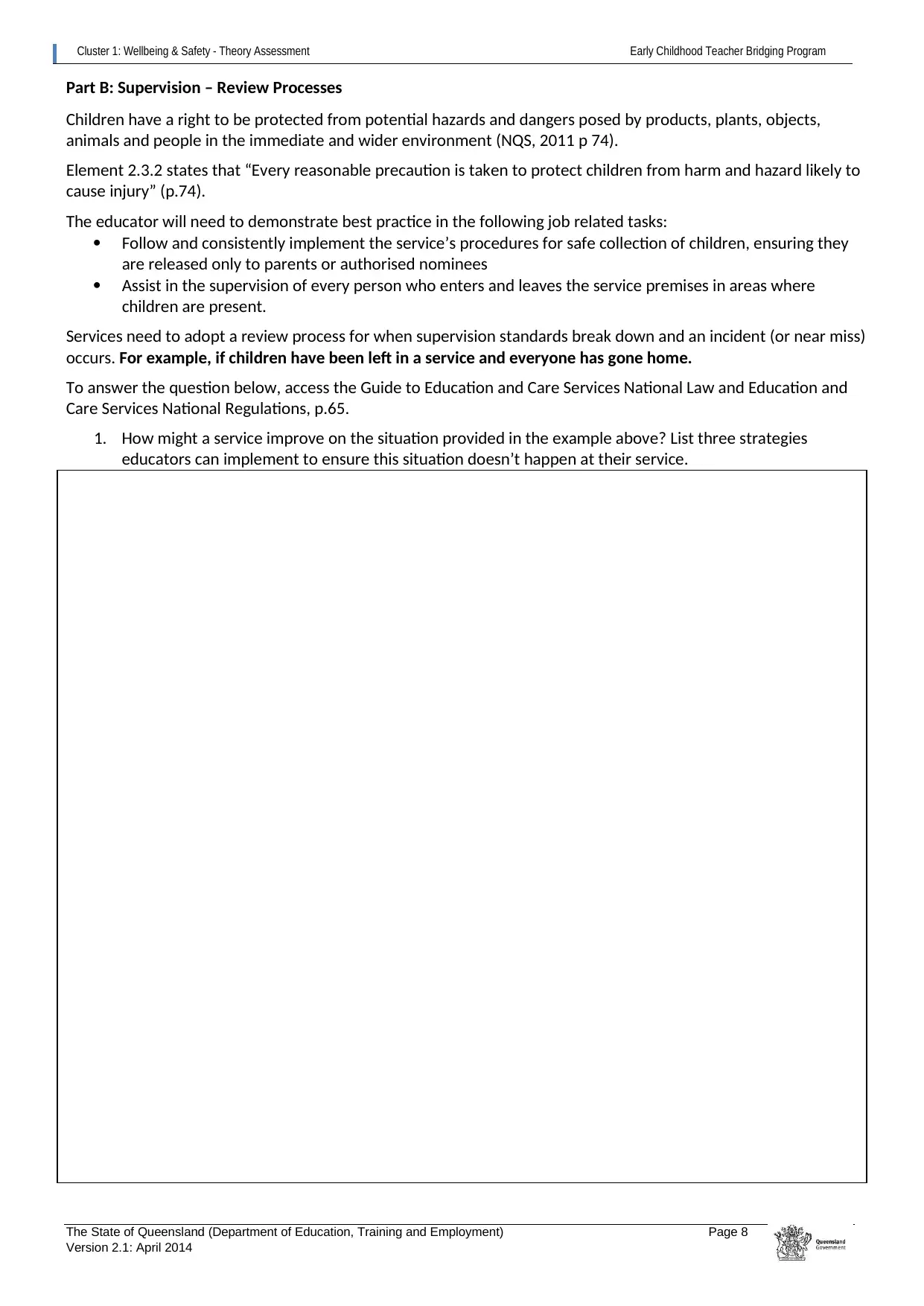
Cluster 1: Wellbeing & Safety - Theory Assessment Early Childhood Teacher Bridging Program
The State of Queensland (Department of Education, Training and Employment) Page 8
Version 2.1: April 2014
Part B: Supervision – Review Processes
Children have a right to be protected from potential hazards and dangers posed by products, plants, objects,
animals and people in the immediate and wider environment (NQS, 2011 p 74).
Element 2.3.2 states that “Every reasonable precaution is taken to protect children from harm and hazard likely to
cause injury” (p.74).
The educator will need to demonstrate best practice in the following job related tasks:
Follow and consistently implement the service’s procedures for safe collection of children, ensuring they
are released only to parents or authorised nominees
Assist in the supervision of every person who enters and leaves the service premises in areas where
children are present.
Services need to adopt a review process for when supervision standards break down and an incident (or near miss)
occurs. For example, if children have been left in a service and everyone has gone home.
To answer the question below, access the Guide to Education and Care Services National Law and Education and
Care Services National Regulations, p.65.
1. How might a service improve on the situation provided in the example above? List three strategies
educators can implement to ensure this situation doesn’t happen at their service.
The State of Queensland (Department of Education, Training and Employment) Page 8
Version 2.1: April 2014
Part B: Supervision – Review Processes
Children have a right to be protected from potential hazards and dangers posed by products, plants, objects,
animals and people in the immediate and wider environment (NQS, 2011 p 74).
Element 2.3.2 states that “Every reasonable precaution is taken to protect children from harm and hazard likely to
cause injury” (p.74).
The educator will need to demonstrate best practice in the following job related tasks:
Follow and consistently implement the service’s procedures for safe collection of children, ensuring they
are released only to parents or authorised nominees
Assist in the supervision of every person who enters and leaves the service premises in areas where
children are present.
Services need to adopt a review process for when supervision standards break down and an incident (or near miss)
occurs. For example, if children have been left in a service and everyone has gone home.
To answer the question below, access the Guide to Education and Care Services National Law and Education and
Care Services National Regulations, p.65.
1. How might a service improve on the situation provided in the example above? List three strategies
educators can implement to ensure this situation doesn’t happen at their service.
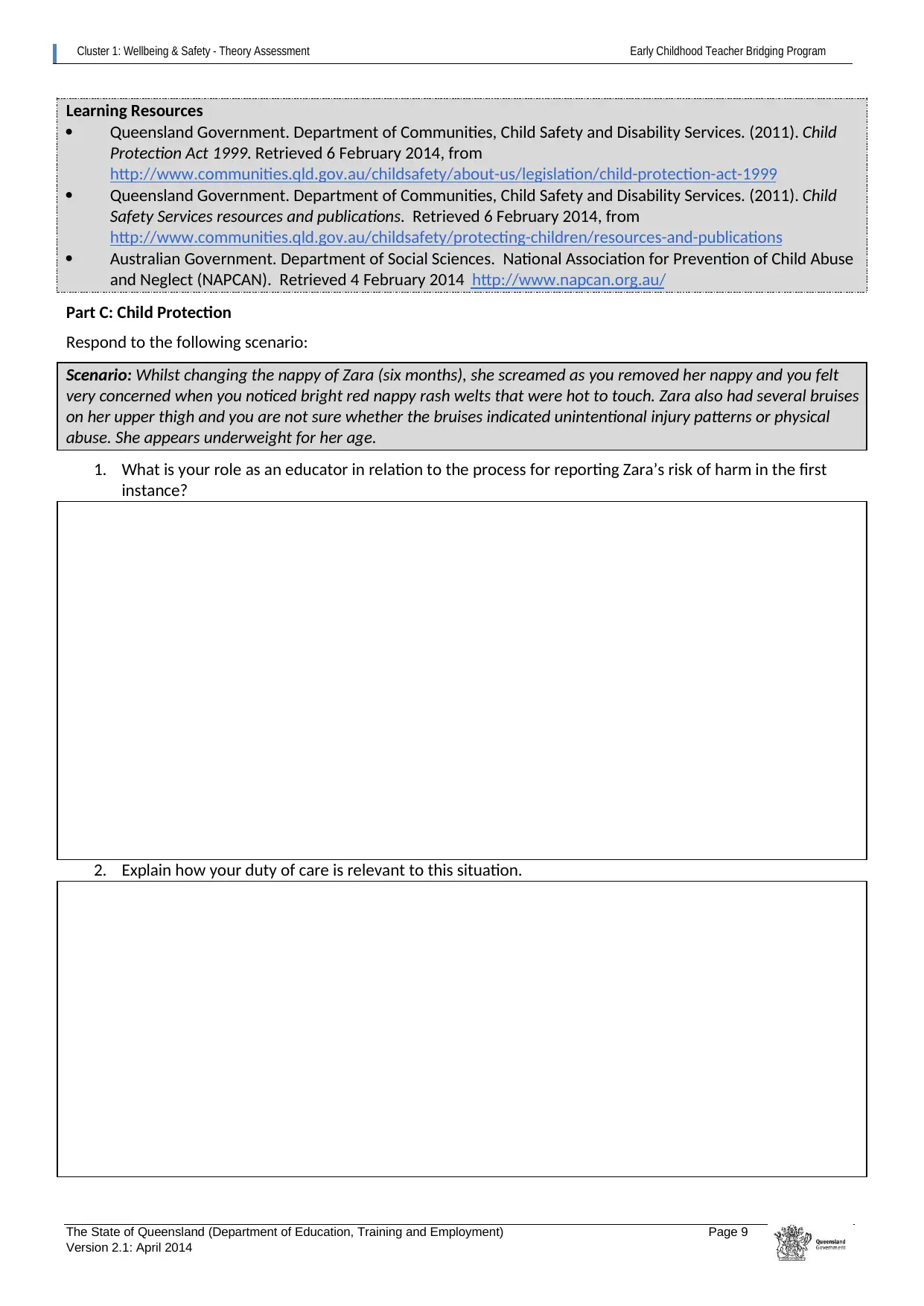
Cluster 1: Wellbeing & Safety - Theory Assessment Early Childhood Teacher Bridging Program
The State of Queensland (Department of Education, Training and Employment) Page 9
Version 2.1: April 2014
Learning Resources
Queensland Government. Department of Communities, Child Safety and Disability Services. (2011). Child
Protection Act 1999. Retrieved 6 February 2014, from
http://www.communities.qld.gov.au/childsafety/about-us/legislation/child-protection-act-1999
Queensland Government. Department of Communities, Child Safety and Disability Services. (2011). Child
Safety Services resources and publications. Retrieved 6 February 2014, from
http://www.communities.qld.gov.au/childsafety/protecting-children/resources-and-publications
Australian Government. Department of Social Sciences. National Association for Prevention of Child Abuse
and Neglect (NAPCAN). Retrieved 4 February 2014 http://www.napcan.org.au/
Part C: Child Protection
Respond to the following scenario:
Scenario: Whilst changing the nappy of Zara (six months), she screamed as you removed her nappy and you felt
very concerned when you noticed bright red nappy rash welts that were hot to touch. Zara also had several bruises
on her upper thigh and you are not sure whether the bruises indicated unintentional injury patterns or physical
abuse. She appears underweight for her age.
1. What is your role as an educator in relation to the process for reporting Zara’s risk of harm in the first
instance?
2. Explain how your duty of care is relevant to this situation.
The State of Queensland (Department of Education, Training and Employment) Page 9
Version 2.1: April 2014
Learning Resources
Queensland Government. Department of Communities, Child Safety and Disability Services. (2011). Child
Protection Act 1999. Retrieved 6 February 2014, from
http://www.communities.qld.gov.au/childsafety/about-us/legislation/child-protection-act-1999
Queensland Government. Department of Communities, Child Safety and Disability Services. (2011). Child
Safety Services resources and publications. Retrieved 6 February 2014, from
http://www.communities.qld.gov.au/childsafety/protecting-children/resources-and-publications
Australian Government. Department of Social Sciences. National Association for Prevention of Child Abuse
and Neglect (NAPCAN). Retrieved 4 February 2014 http://www.napcan.org.au/
Part C: Child Protection
Respond to the following scenario:
Scenario: Whilst changing the nappy of Zara (six months), she screamed as you removed her nappy and you felt
very concerned when you noticed bright red nappy rash welts that were hot to touch. Zara also had several bruises
on her upper thigh and you are not sure whether the bruises indicated unintentional injury patterns or physical
abuse. She appears underweight for her age.
1. What is your role as an educator in relation to the process for reporting Zara’s risk of harm in the first
instance?
2. Explain how your duty of care is relevant to this situation.
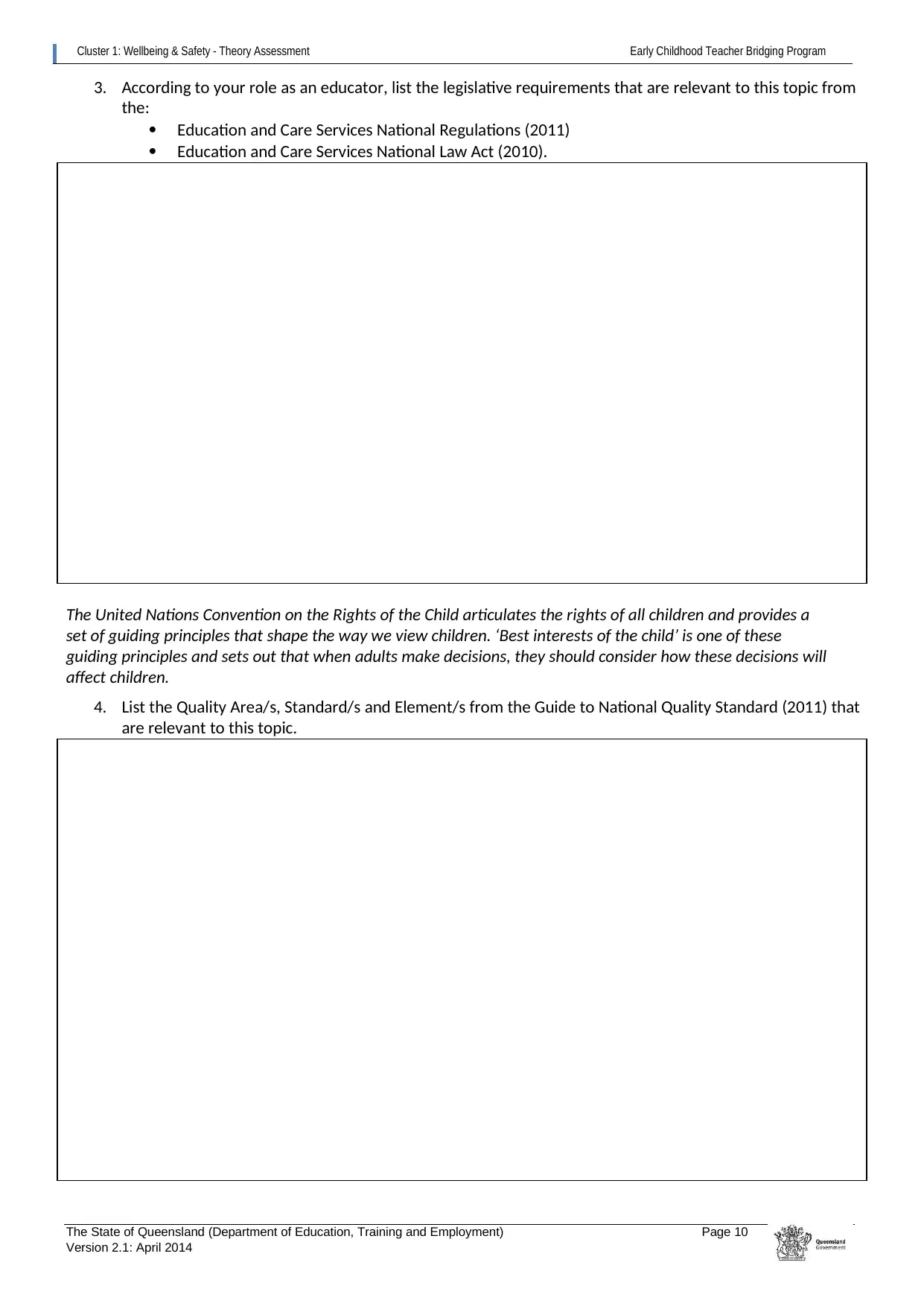
Cluster 1: Wellbeing & Safety - Theory Assessment Early Childhood Teacher Bridging Program
The State of Queensland (Department of Education, Training and Employment) Page 10
Version 2.1: April 2014
3. According to your role as an educator, list the legislative requirements that are relevant to this topic from
the:
Education and Care Services National Regulations (2011)
Education and Care Services National Law Act (2010).
The United Nations Convention on the Rights of the Child articulates the rights of all children and provides a
set of guiding principles that shape the way we view children. ‘Best interests of the child’ is one of these
guiding principles and sets out that when adults make decisions, they should consider how these decisions will
affect children.
4. List the Quality Area/s, Standard/s and Element/s from the Guide to National Quality Standard (2011) that
are relevant to this topic.
The State of Queensland (Department of Education, Training and Employment) Page 10
Version 2.1: April 2014
3. According to your role as an educator, list the legislative requirements that are relevant to this topic from
the:
Education and Care Services National Regulations (2011)
Education and Care Services National Law Act (2010).
The United Nations Convention on the Rights of the Child articulates the rights of all children and provides a
set of guiding principles that shape the way we view children. ‘Best interests of the child’ is one of these
guiding principles and sets out that when adults make decisions, they should consider how these decisions will
affect children.
4. List the Quality Area/s, Standard/s and Element/s from the Guide to National Quality Standard (2011) that
are relevant to this topic.
Paraphrase This Document
Need a fresh take? Get an instant paraphrase of this document with our AI Paraphraser
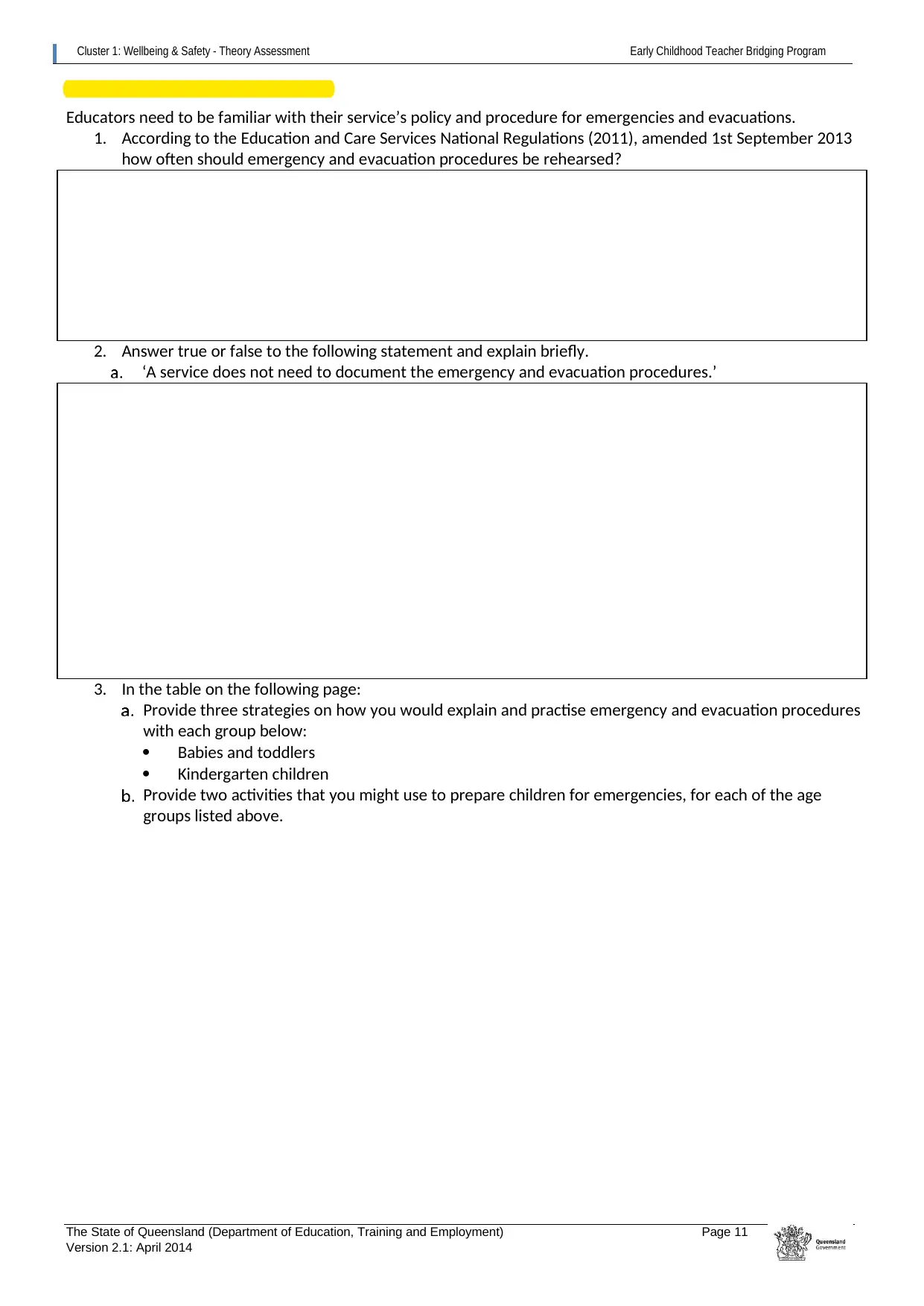
Cluster 1: Wellbeing & Safety - Theory Assessment Early Childhood Teacher Bridging Program
The State of Queensland (Department of Education, Training and Employment) Page 11
Version 2.1: April 2014
Part D: Emergencies and Evacuations
Educators need to be familiar with their service’s policy and procedure for emergencies and evacuations.
1. According to the Education and Care Services National Regulations (2011), amended 1st September 2013
how often should emergency and evacuation procedures be rehearsed?
2. Answer true or false to the following statement and explain briefly.
‘A service does not need to document the emergency and evacuation procedures.’
3. In the table on the following page:
Provide three strategies on how you would explain and practise emergency and evacuation procedures
with each group below:
Babies and toddlers
Kindergarten children
Provide two activities that you might use to prepare children for emergencies, for each of the age
groups listed above.
The State of Queensland (Department of Education, Training and Employment) Page 11
Version 2.1: April 2014
Part D: Emergencies and Evacuations
Educators need to be familiar with their service’s policy and procedure for emergencies and evacuations.
1. According to the Education and Care Services National Regulations (2011), amended 1st September 2013
how often should emergency and evacuation procedures be rehearsed?
2. Answer true or false to the following statement and explain briefly.
‘A service does not need to document the emergency and evacuation procedures.’
3. In the table on the following page:
Provide three strategies on how you would explain and practise emergency and evacuation procedures
with each group below:
Babies and toddlers
Kindergarten children
Provide two activities that you might use to prepare children for emergencies, for each of the age
groups listed above.
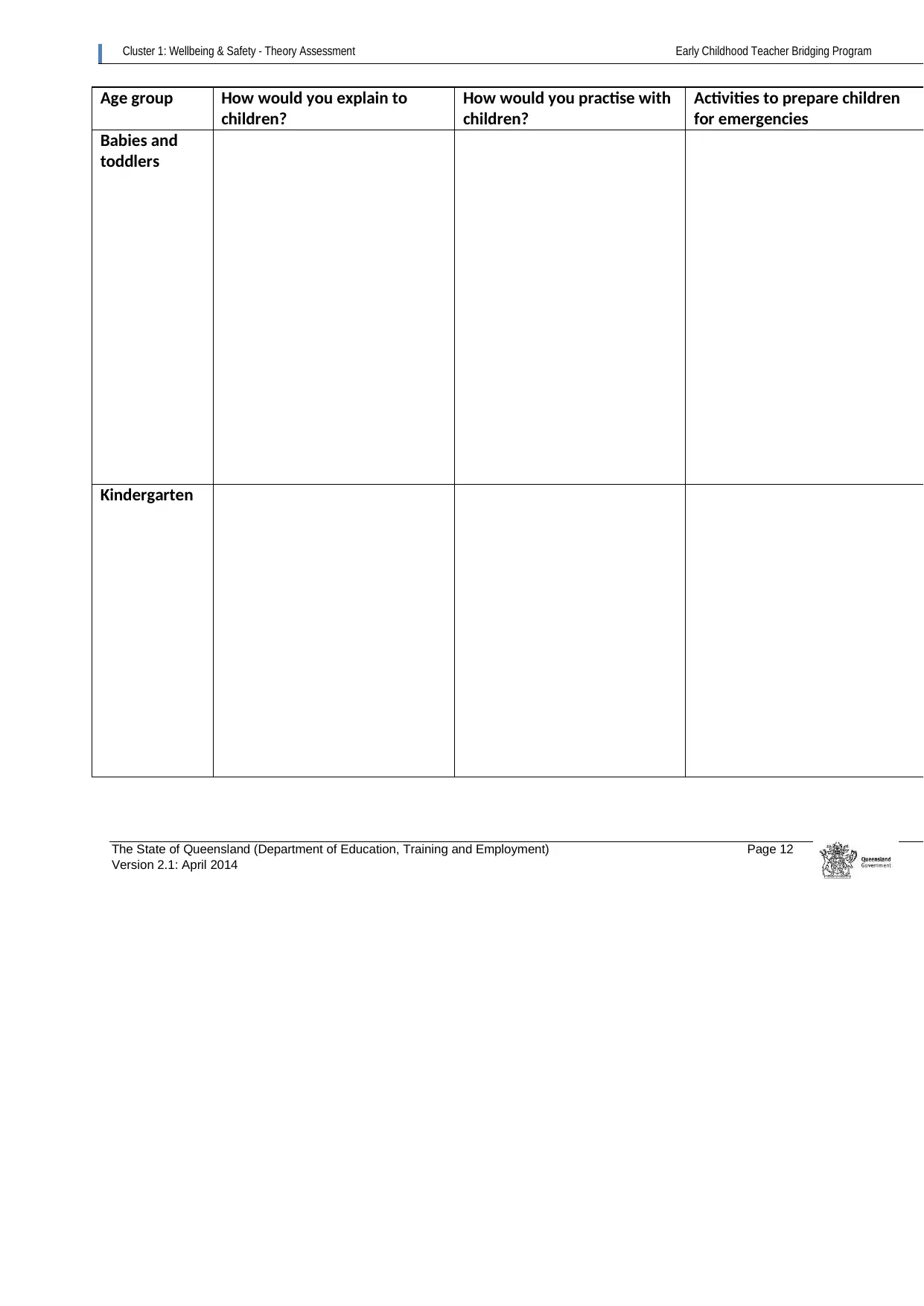
Cluster 1: Wellbeing & Safety - Theory Assessment Early Childhood Teacher Bridging Program
The State of Queensland (Department of Education, Training and Employment) Page 12
Version 2.1: April 2014
Age group How would you explain to
children?
How would you practise with
children?
Activities to prepare children
for emergencies
Babies and
toddlers
Kindergarten
The State of Queensland (Department of Education, Training and Employment) Page 12
Version 2.1: April 2014
Age group How would you explain to
children?
How would you practise with
children?
Activities to prepare children
for emergencies
Babies and
toddlers
Kindergarten
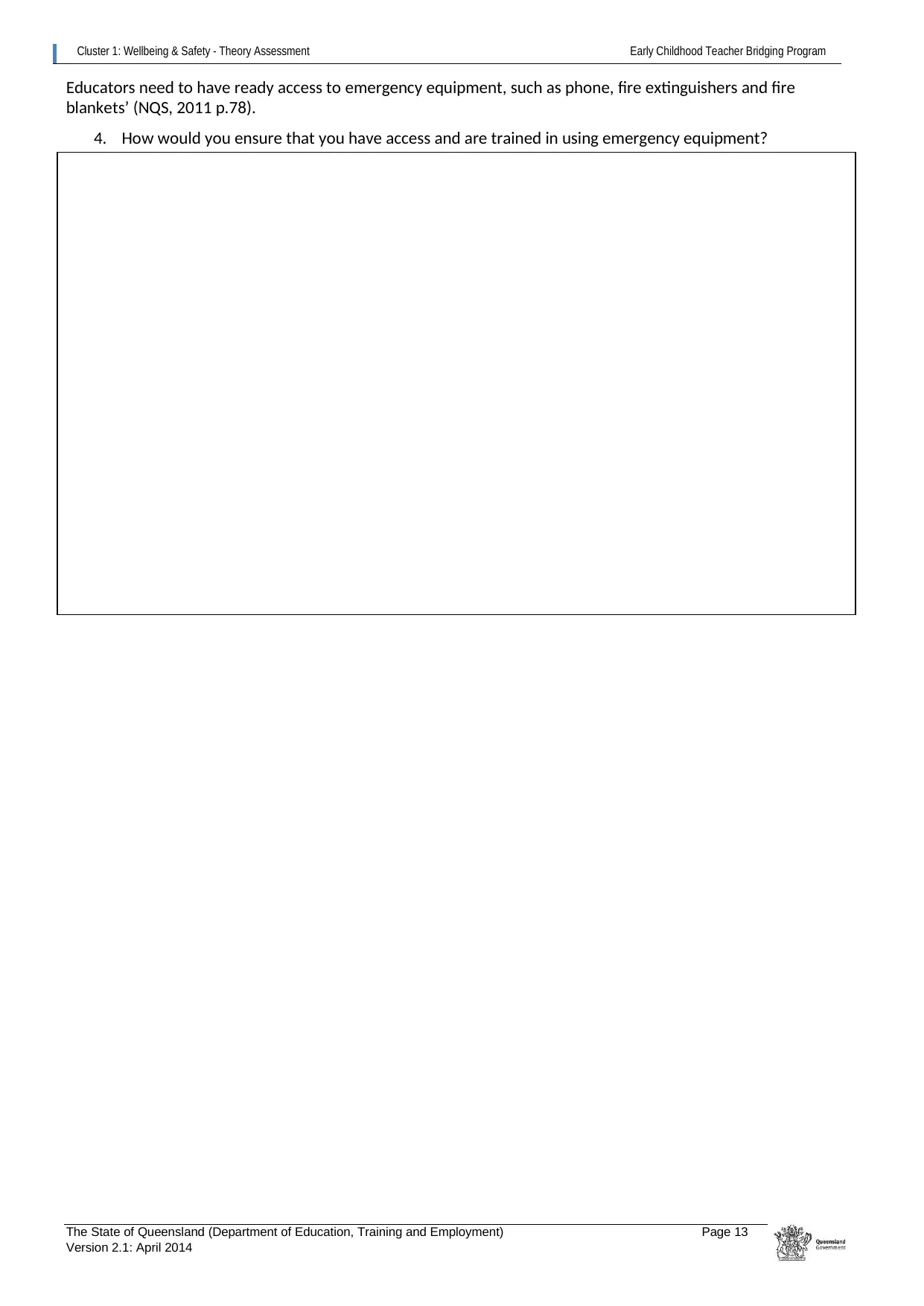
Cluster 1: Wellbeing & Safety - Theory Assessment Early Childhood Teacher Bridging Program
The State of Queensland (Department of Education, Training and Employment) Page 13
Version 2.1: April 2014
Educators need to have ready access to emergency equipment, such as phone, fire extinguishers and fire
blankets’ (NQS, 2011 p.78).
4. How would you ensure that you have access and are trained in using emergency equipment?
The State of Queensland (Department of Education, Training and Employment) Page 13
Version 2.1: April 2014
Educators need to have ready access to emergency equipment, such as phone, fire extinguishers and fire
blankets’ (NQS, 2011 p.78).
4. How would you ensure that you have access and are trained in using emergency equipment?
Secure Best Marks with AI Grader
Need help grading? Try our AI Grader for instant feedback on your assignments.
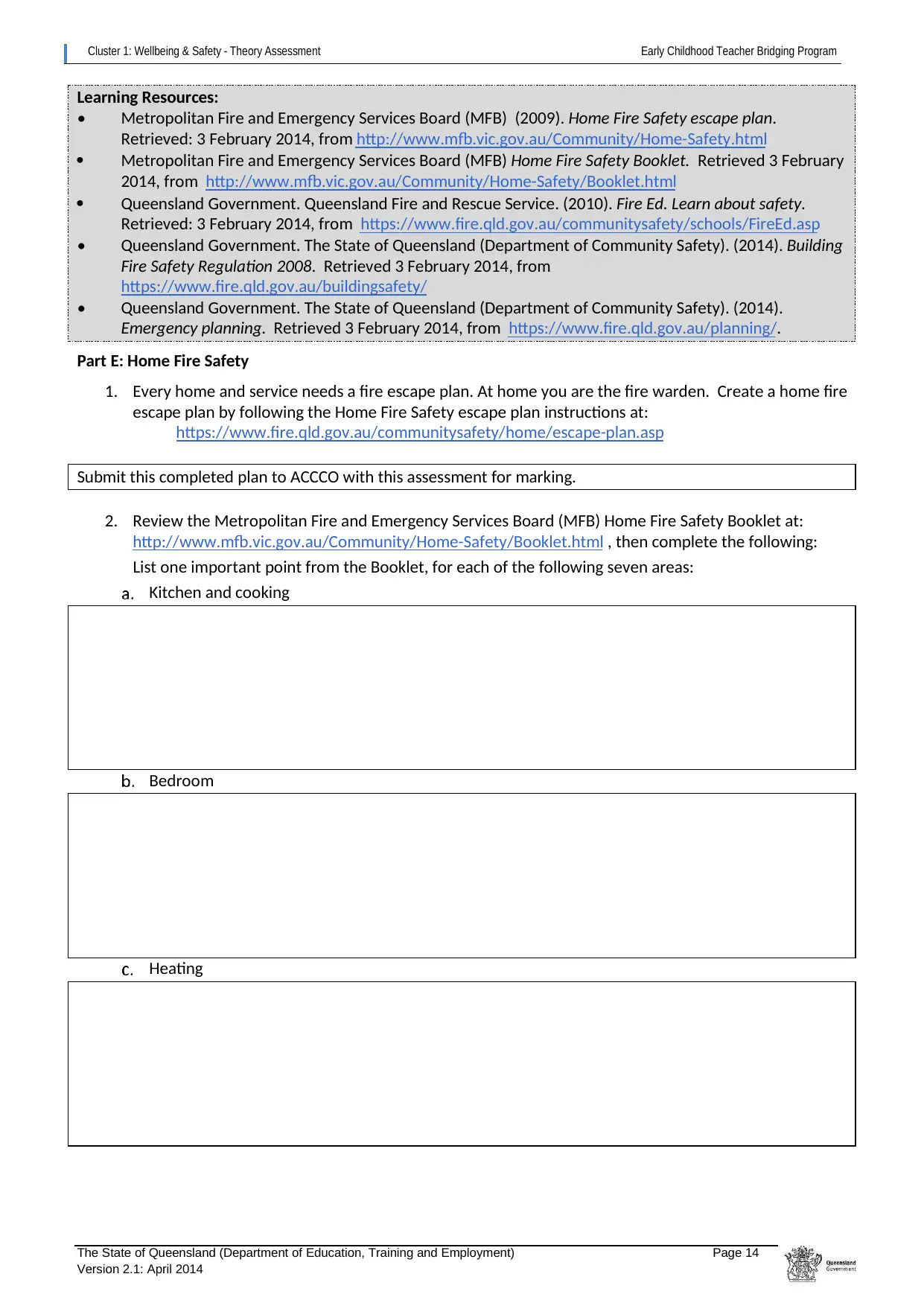
Cluster 1: Wellbeing & Safety - Theory Assessment Early Childhood Teacher Bridging Program
The State of Queensland (Department of Education, Training and Employment) Page 14
Version 2.1: April 2014
Learning Resources:
• Metropolitan Fire and Emergency Services Board (MFB) (2009). Home Fire Safety escape plan.
Retrieved: 3 February 2014, from http://www.mfb.vic.gov.au/Community/Home-Safety.html
Metropolitan Fire and Emergency Services Board (MFB) Home Fire Safety Booklet. Retrieved 3 February
2014, from http://www.mfb.vic.gov.au/Community/Home-Safety/Booklet.html
Queensland Government. Queensland Fire and Rescue Service. (2010). Fire Ed. Learn about safety.
Retrieved: 3 February 2014, from https://www.fire.qld.gov.au/communitysafety/schools/FireEd.asp
• Queensland Government. The State of Queensland (Department of Community Safety). (2014). Building
Fire Safety Regulation 2008. Retrieved 3 February 2014, from
https://www.fire.qld.gov.au/buildingsafety/
• Queensland Government. The State of Queensland (Department of Community Safety). (2014).
Emergency planning. Retrieved 3 February 2014, from https://www.fire.qld.gov.au/planning/.
Part E: Home Fire Safety
1. Every home and service needs a fire escape plan. At home you are the fire warden. Create a home fire
escape plan by following the Home Fire Safety escape plan instructions at:
https://www.fire.qld.gov.au/communitysafety/home/escape-plan.asp
Submit this completed plan to ACCCO with this assessment for marking.
2. Review the Metropolitan Fire and Emergency Services Board (MFB) Home Fire Safety Booklet at:
http://www.mfb.vic.gov.au/Community/Home-Safety/Booklet.html , then complete the following:
List one important point from the Booklet, for each of the following seven areas:
Kitchen and cooking
Bedroom
Heating
The State of Queensland (Department of Education, Training and Employment) Page 14
Version 2.1: April 2014
Learning Resources:
• Metropolitan Fire and Emergency Services Board (MFB) (2009). Home Fire Safety escape plan.
Retrieved: 3 February 2014, from http://www.mfb.vic.gov.au/Community/Home-Safety.html
Metropolitan Fire and Emergency Services Board (MFB) Home Fire Safety Booklet. Retrieved 3 February
2014, from http://www.mfb.vic.gov.au/Community/Home-Safety/Booklet.html
Queensland Government. Queensland Fire and Rescue Service. (2010). Fire Ed. Learn about safety.
Retrieved: 3 February 2014, from https://www.fire.qld.gov.au/communitysafety/schools/FireEd.asp
• Queensland Government. The State of Queensland (Department of Community Safety). (2014). Building
Fire Safety Regulation 2008. Retrieved 3 February 2014, from
https://www.fire.qld.gov.au/buildingsafety/
• Queensland Government. The State of Queensland (Department of Community Safety). (2014).
Emergency planning. Retrieved 3 February 2014, from https://www.fire.qld.gov.au/planning/.
Part E: Home Fire Safety
1. Every home and service needs a fire escape plan. At home you are the fire warden. Create a home fire
escape plan by following the Home Fire Safety escape plan instructions at:
https://www.fire.qld.gov.au/communitysafety/home/escape-plan.asp
Submit this completed plan to ACCCO with this assessment for marking.
2. Review the Metropolitan Fire and Emergency Services Board (MFB) Home Fire Safety Booklet at:
http://www.mfb.vic.gov.au/Community/Home-Safety/Booklet.html , then complete the following:
List one important point from the Booklet, for each of the following seven areas:
Kitchen and cooking
Bedroom
Heating

Cluster 1: Wellbeing & Safety - Theory Assessment Early Childhood Teacher Bridging Program
The State of Queensland (Department of Education, Training and Employment) Page 15
Version 2.1: April 2014
Electricity
Open flame
Laundry and BBQ
Smoke alarm
The State of Queensland (Department of Education, Training and Employment) Page 15
Version 2.1: April 2014
Electricity
Open flame
Laundry and BBQ
Smoke alarm
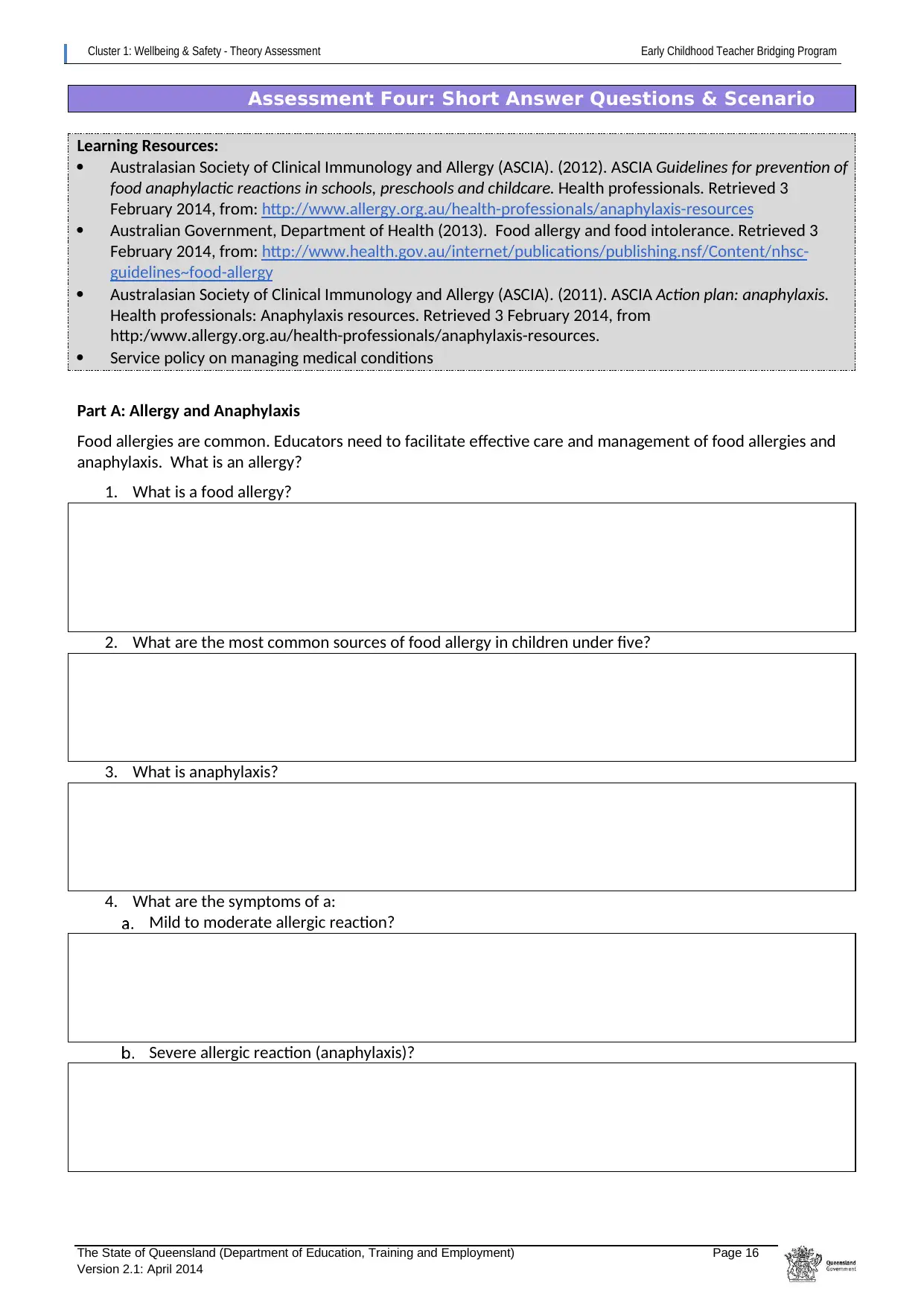
Cluster 1: Wellbeing & Safety - Theory Assessment Early Childhood Teacher Bridging Program
The State of Queensland (Department of Education, Training and Employment) Page 16
Version 2.1: April 2014
Assessment Four: Short Answer Questions & Scenario
Learning Resources:
Australasian Society of Clinical Immunology and Allergy (ASCIA). (2012). ASCIA Guidelines for prevention of
food anaphylactic reactions in schools, preschools and childcare. Health professionals. Retrieved 3
February 2014, from: http://www.allergy.org.au/health-professionals/anaphylaxis-resources
Australian Government, Department of Health (2013). Food allergy and food intolerance. Retrieved 3
February 2014, from: http://www.health.gov.au/internet/publications/publishing.nsf/Content/nhsc-
guidelines~food-allergy
Australasian Society of Clinical Immunology and Allergy (ASCIA). (2011). ASCIA Action plan: anaphylaxis.
Health professionals: Anaphylaxis resources. Retrieved 3 February 2014, from
http:/www.allergy.org.au/health-professionals/anaphylaxis-resources.
Service policy on managing medical conditions
Part A: Allergy and Anaphylaxis
Food allergies are common. Educators need to facilitate effective care and management of food allergies and
anaphylaxis. What is an allergy?
1. What is a food allergy?
2. What are the most common sources of food allergy in children under five?
3. What is anaphylaxis?
4. What are the symptoms of a:
Mild to moderate allergic reaction?
Severe allergic reaction (anaphylaxis)?
The State of Queensland (Department of Education, Training and Employment) Page 16
Version 2.1: April 2014
Assessment Four: Short Answer Questions & Scenario
Learning Resources:
Australasian Society of Clinical Immunology and Allergy (ASCIA). (2012). ASCIA Guidelines for prevention of
food anaphylactic reactions in schools, preschools and childcare. Health professionals. Retrieved 3
February 2014, from: http://www.allergy.org.au/health-professionals/anaphylaxis-resources
Australian Government, Department of Health (2013). Food allergy and food intolerance. Retrieved 3
February 2014, from: http://www.health.gov.au/internet/publications/publishing.nsf/Content/nhsc-
guidelines~food-allergy
Australasian Society of Clinical Immunology and Allergy (ASCIA). (2011). ASCIA Action plan: anaphylaxis.
Health professionals: Anaphylaxis resources. Retrieved 3 February 2014, from
http:/www.allergy.org.au/health-professionals/anaphylaxis-resources.
Service policy on managing medical conditions
Part A: Allergy and Anaphylaxis
Food allergies are common. Educators need to facilitate effective care and management of food allergies and
anaphylaxis. What is an allergy?
1. What is a food allergy?
2. What are the most common sources of food allergy in children under five?
3. What is anaphylaxis?
4. What are the symptoms of a:
Mild to moderate allergic reaction?
Severe allergic reaction (anaphylaxis)?
Paraphrase This Document
Need a fresh take? Get an instant paraphrase of this document with our AI Paraphraser
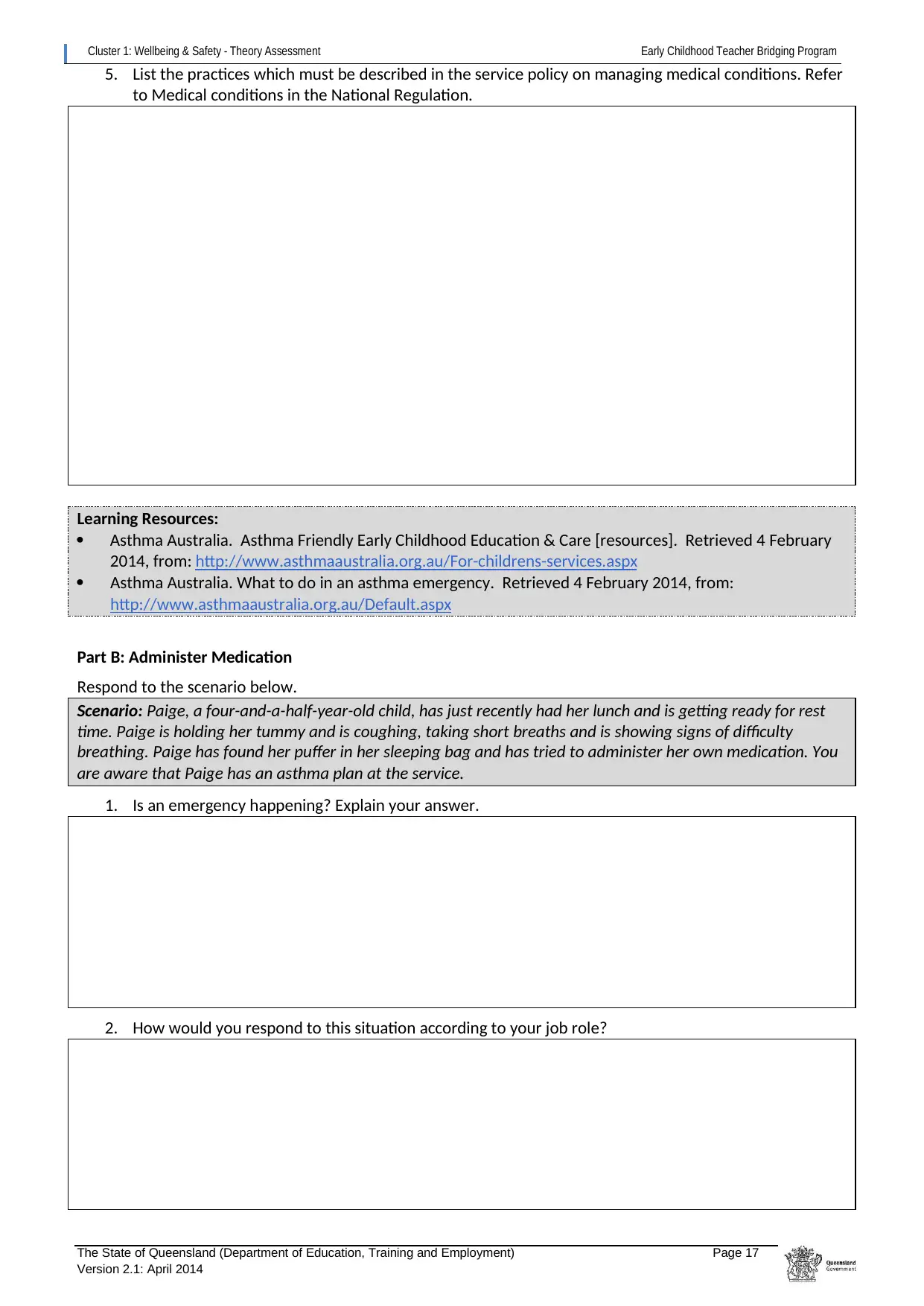
Cluster 1: Wellbeing & Safety - Theory Assessment Early Childhood Teacher Bridging Program
The State of Queensland (Department of Education, Training and Employment) Page 17
Version 2.1: April 2014
5. List the practices which must be described in the service policy on managing medical conditions. Refer
to Medical conditions in the National Regulation.
Learning Resources:
Asthma Australia. Asthma Friendly Early Childhood Education & Care [resources]. Retrieved 4 February
2014, from: http://www.asthmaaustralia.org.au/For-childrens-services.aspx
Asthma Australia. What to do in an asthma emergency. Retrieved 4 February 2014, from:
http://www.asthmaaustralia.org.au/Default.aspx
Part B: Administer Medication
Respond to the scenario below.
Scenario: Paige, a four-and-a-half-year-old child, has just recently had her lunch and is getting ready for rest
time. Paige is holding her tummy and is coughing, taking short breaths and is showing signs of difficulty
breathing. Paige has found her puffer in her sleeping bag and has tried to administer her own medication. You
are aware that Paige has an asthma plan at the service.
1. Is an emergency happening? Explain your answer.
2. How would you respond to this situation according to your job role?
The State of Queensland (Department of Education, Training and Employment) Page 17
Version 2.1: April 2014
5. List the practices which must be described in the service policy on managing medical conditions. Refer
to Medical conditions in the National Regulation.
Learning Resources:
Asthma Australia. Asthma Friendly Early Childhood Education & Care [resources]. Retrieved 4 February
2014, from: http://www.asthmaaustralia.org.au/For-childrens-services.aspx
Asthma Australia. What to do in an asthma emergency. Retrieved 4 February 2014, from:
http://www.asthmaaustralia.org.au/Default.aspx
Part B: Administer Medication
Respond to the scenario below.
Scenario: Paige, a four-and-a-half-year-old child, has just recently had her lunch and is getting ready for rest
time. Paige is holding her tummy and is coughing, taking short breaths and is showing signs of difficulty
breathing. Paige has found her puffer in her sleeping bag and has tried to administer her own medication. You
are aware that Paige has an asthma plan at the service.
1. Is an emergency happening? Explain your answer.
2. How would you respond to this situation according to your job role?
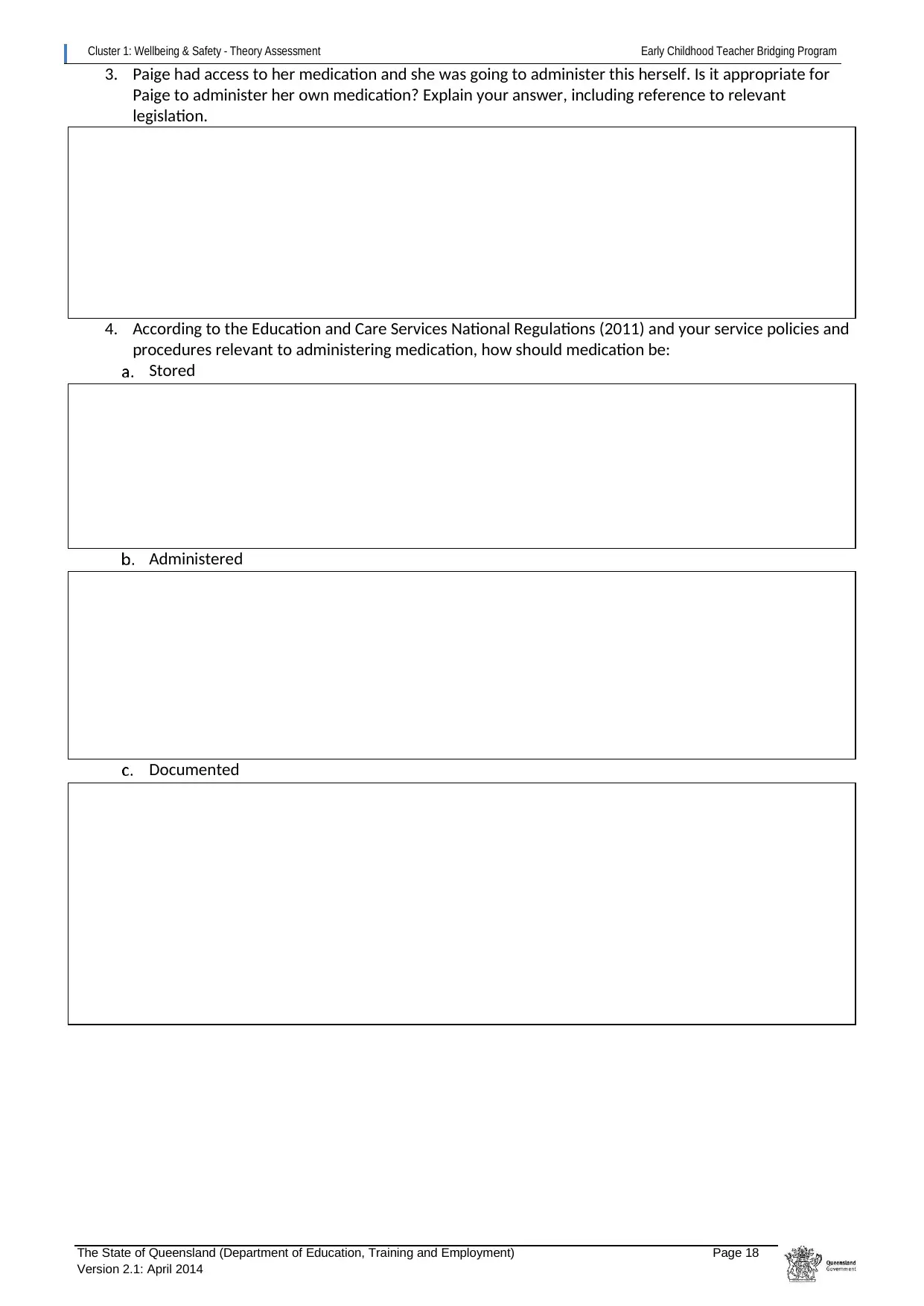
Cluster 1: Wellbeing & Safety - Theory Assessment Early Childhood Teacher Bridging Program
The State of Queensland (Department of Education, Training and Employment) Page 18
Version 2.1: April 2014
3. Paige had access to her medication and she was going to administer this herself. Is it appropriate for
Paige to administer her own medication? Explain your answer, including reference to relevant
legislation.
4. According to the Education and Care Services National Regulations (2011) and your service policies and
procedures relevant to administering medication, how should medication be:
Stored
Administered
Documented
The State of Queensland (Department of Education, Training and Employment) Page 18
Version 2.1: April 2014
3. Paige had access to her medication and she was going to administer this herself. Is it appropriate for
Paige to administer her own medication? Explain your answer, including reference to relevant
legislation.
4. According to the Education and Care Services National Regulations (2011) and your service policies and
procedures relevant to administering medication, how should medication be:
Stored
Administered
Documented

Cluster 1: Wellbeing & Safety - Theory Assessment Early Childhood Teacher Bridging Program
The State of Queensland (Department of Education, Training and Employment) Page 19
Version 2.1: April 2014
Assessment Five: Scenario
Learning Resources:
Raising Children Network (2015) Sleep information
http://raisingchildren.net.au/sleep/babies_sleep.html
http://raisingchildren.net.au/sleep/toddlers_sleep.html
http://raisingchildren.net.au/sleep/preschoolers_sleep.html
SIDS and kids (2015) Safe Sleeping http://www.sidsandkids.org/safe-sleeping/
Part A: Sleep, Rest and Relaxation
Regulation 81: Sleep and Rest
The approved provider of an education and care service must take reasonable steps to ensure that the
needs for sleep and rest of children being educated and cared for by the service are met, having
regard to the ages, development stages and individual needs of the children (Education and Care
Services National Regulations, p.101).
Read the following scenario and answer the questions to demonstrate your knowledge and skills in providing
for children’s individual needs.
Scenario: Ahmed’s story
Ahmed is a three-year-old boy who has been attending the education and care service part-time. His
grandmother recently passed away and Ahmed will now have to attend the service full-time. Ahmed’s family
do not speak English at home and his mum often brings in Ahmed’s older brother to ask questions about
Ahmed’s day. At times Ahmed appears easily upset on arrival and often falls asleep while lunch is being served
at noon. Ahmed enjoys playing with Lego and blocks, riding trikes outdoors, and digging in the sandpit with the
large trucks. Ahmed is usually able to take care of his own toileting needs, although there have been occasions
when he has had ‘accidents’ and has needed to change his clothing.
1. List two examples of how the educator can support Ahmed’s needs for sleep, rest and relaxation.
2. List two examples of how the environment can be set up to support Ahmed’s needs for sleep and rest,
comfort and safety according to approved standards.
The State of Queensland (Department of Education, Training and Employment) Page 19
Version 2.1: April 2014
Assessment Five: Scenario
Learning Resources:
Raising Children Network (2015) Sleep information
http://raisingchildren.net.au/sleep/babies_sleep.html
http://raisingchildren.net.au/sleep/toddlers_sleep.html
http://raisingchildren.net.au/sleep/preschoolers_sleep.html
SIDS and kids (2015) Safe Sleeping http://www.sidsandkids.org/safe-sleeping/
Part A: Sleep, Rest and Relaxation
Regulation 81: Sleep and Rest
The approved provider of an education and care service must take reasonable steps to ensure that the
needs for sleep and rest of children being educated and cared for by the service are met, having
regard to the ages, development stages and individual needs of the children (Education and Care
Services National Regulations, p.101).
Read the following scenario and answer the questions to demonstrate your knowledge and skills in providing
for children’s individual needs.
Scenario: Ahmed’s story
Ahmed is a three-year-old boy who has been attending the education and care service part-time. His
grandmother recently passed away and Ahmed will now have to attend the service full-time. Ahmed’s family
do not speak English at home and his mum often brings in Ahmed’s older brother to ask questions about
Ahmed’s day. At times Ahmed appears easily upset on arrival and often falls asleep while lunch is being served
at noon. Ahmed enjoys playing with Lego and blocks, riding trikes outdoors, and digging in the sandpit with the
large trucks. Ahmed is usually able to take care of his own toileting needs, although there have been occasions
when he has had ‘accidents’ and has needed to change his clothing.
1. List two examples of how the educator can support Ahmed’s needs for sleep, rest and relaxation.
2. List two examples of how the environment can be set up to support Ahmed’s needs for sleep and rest,
comfort and safety according to approved standards.
Secure Best Marks with AI Grader
Need help grading? Try our AI Grader for instant feedback on your assignments.

Cluster 1: Wellbeing & Safety - Theory Assessment Early Childhood Teacher Bridging Program
The State of Queensland (Department of Education, Training and Employment) Page 20
Version 2.1: April 2014
3. How might you communicate and share information about Ahmed’s sleep and rest needs with his
family? List three examples.
The State of Queensland (Department of Education, Training and Employment) Page 20
Version 2.1: April 2014
3. How might you communicate and share information about Ahmed’s sleep and rest needs with his
family? List three examples.
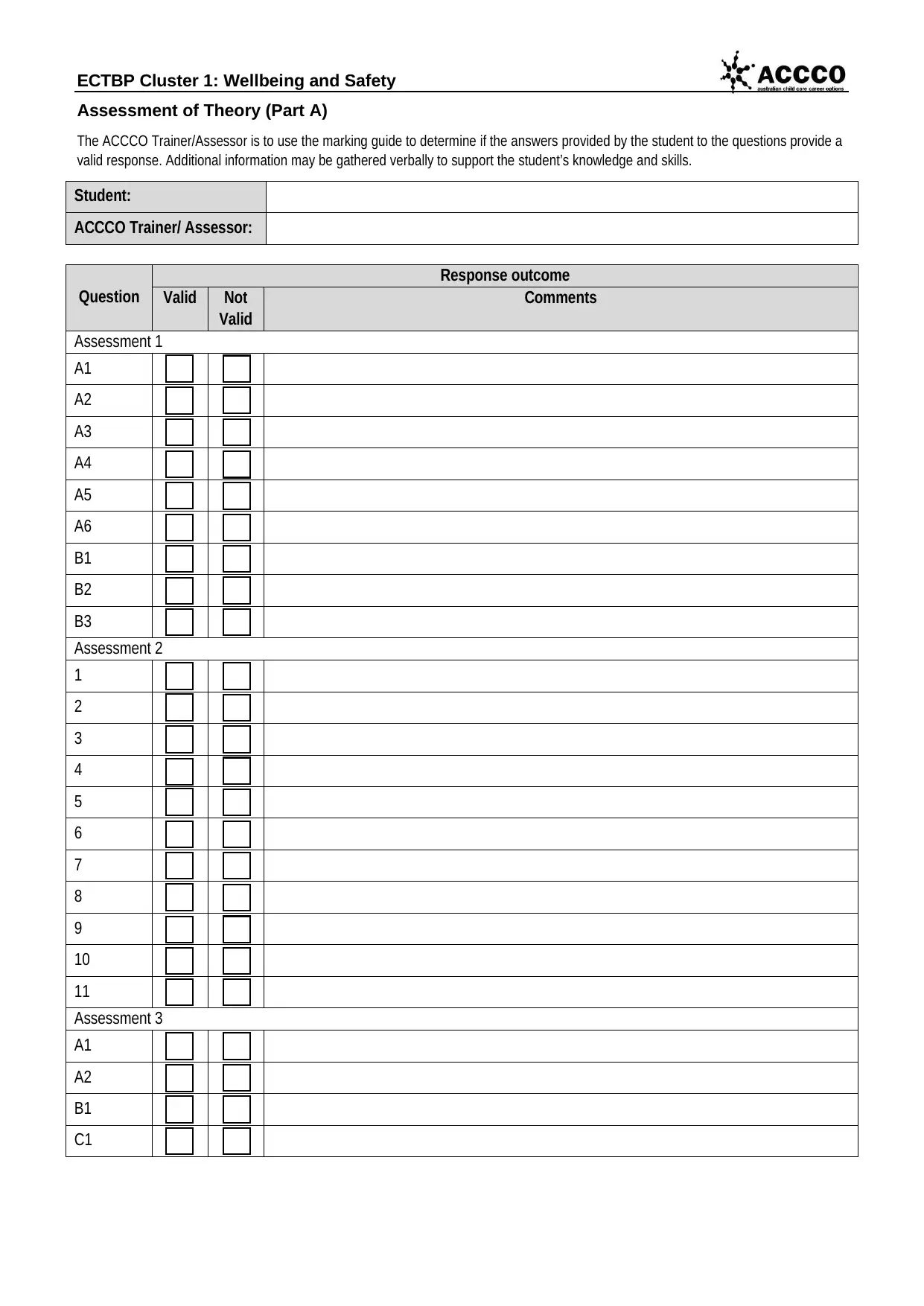
ECTBP Cluster 1: Wellbeing and Safety
Assessment of Theory (Part A)
The ACCCO Trainer/Assessor is to use the marking guide to determine if the answers provided by the student to the questions provide a
valid response. Additional information may be gathered verbally to support the student’s knowledge and skills.
Student:
ACCCO Trainer/ Assessor:
Question
Response outcome
Valid Not
Valid
Comments
Assessment 1
A1
A2
A3
A4
A5
A6
B1
B2
B3
Assessment 2
1
2
3
4
5
6
7
8
9
10
11
Assessment 3
A1
A2
B1
C1
Assessment of Theory (Part A)
The ACCCO Trainer/Assessor is to use the marking guide to determine if the answers provided by the student to the questions provide a
valid response. Additional information may be gathered verbally to support the student’s knowledge and skills.
Student:
ACCCO Trainer/ Assessor:
Question
Response outcome
Valid Not
Valid
Comments
Assessment 1
A1
A2
A3
A4
A5
A6
B1
B2
B3
Assessment 2
1
2
3
4
5
6
7
8
9
10
11
Assessment 3
A1
A2
B1
C1
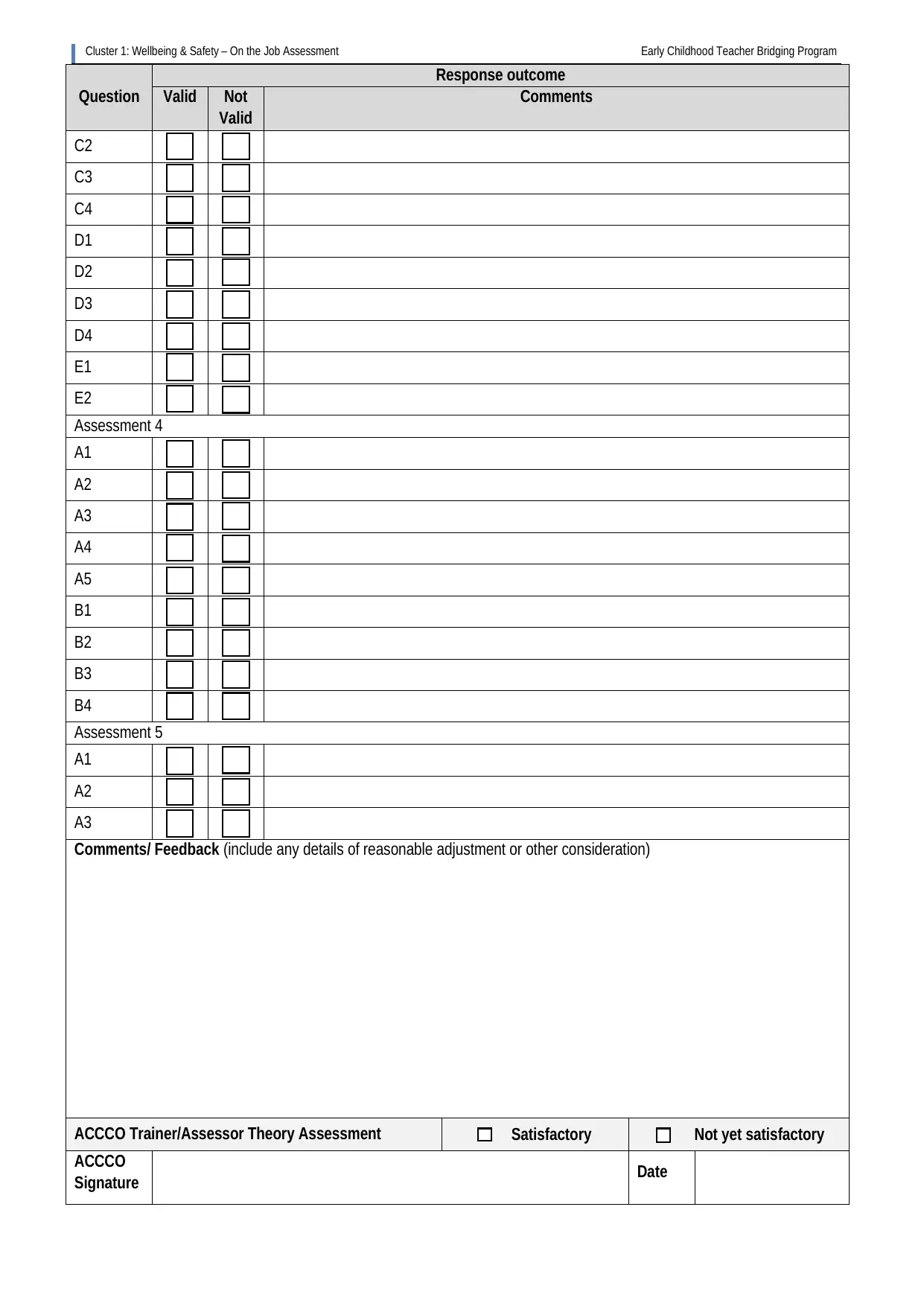
Cluster 1: Wellbeing & Safety – On the Job Assessment Early Childhood Teacher Bridging Program
Question
Response outcome
Valid Not
Valid
Comments
C2
C3
C4
D1
D2
D3
D4
E1
E2
Assessment 4
A1
A2
A3
A4
A5
B1
B2
B3
B4
Assessment 5
A1
A2
A3
Comments/ Feedback (include any details of reasonable adjustment or other consideration)
ACCCO Trainer/Assessor Theory Assessment Satisfactory Not yet satisfactory
ACCCO
Signature Date
Question
Response outcome
Valid Not
Valid
Comments
C2
C3
C4
D1
D2
D3
D4
E1
E2
Assessment 4
A1
A2
A3
A4
A5
B1
B2
B3
B4
Assessment 5
A1
A2
A3
Comments/ Feedback (include any details of reasonable adjustment or other consideration)
ACCCO Trainer/Assessor Theory Assessment Satisfactory Not yet satisfactory
ACCCO
Signature Date
Paraphrase This Document
Need a fresh take? Get an instant paraphrase of this document with our AI Paraphraser
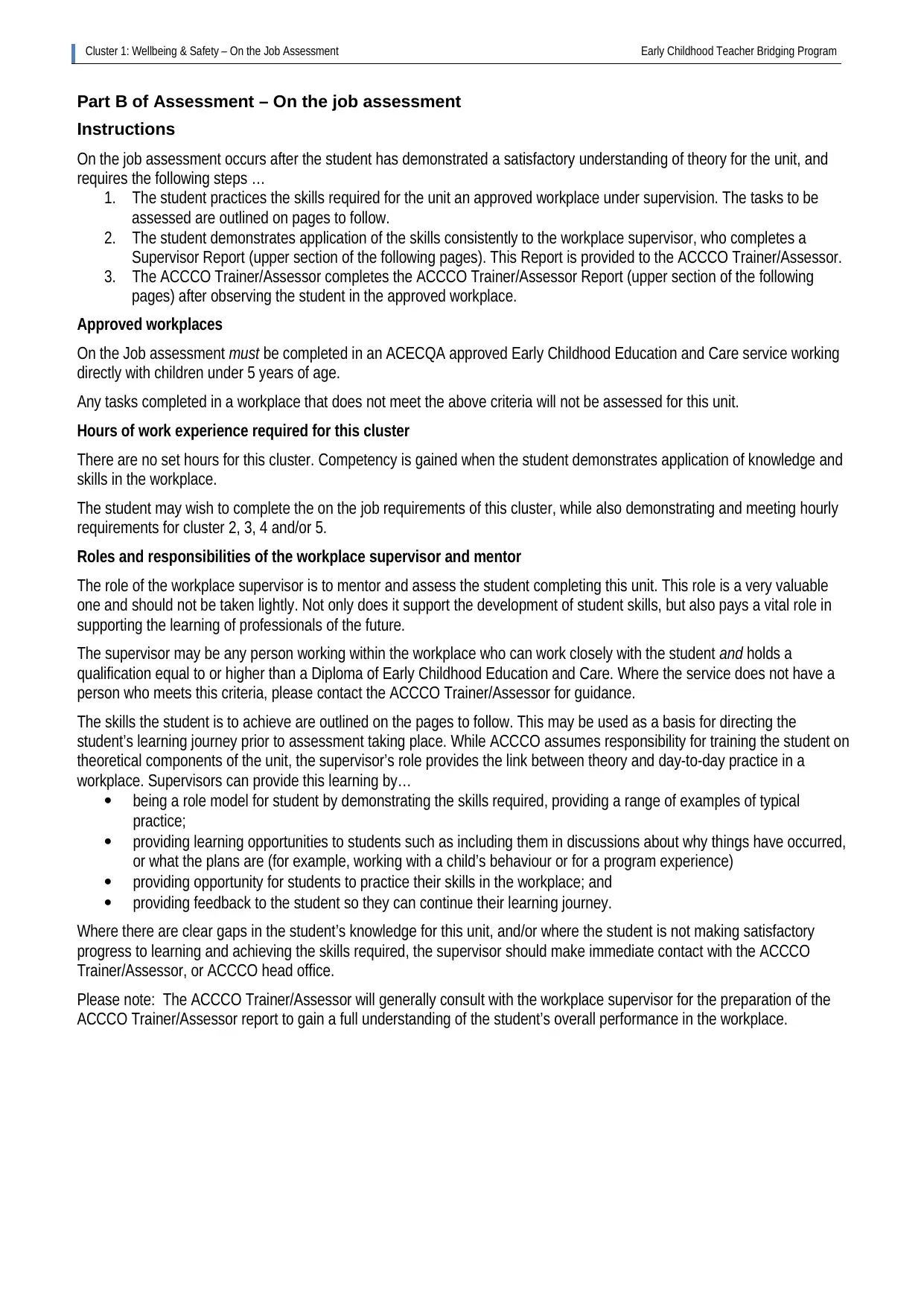
Cluster 1: Wellbeing & Safety – On the Job Assessment Early Childhood Teacher Bridging Program
Part B of Assessment – On the job assessment
Instructions
On the job assessment occurs after the student has demonstrated a satisfactory understanding of theory for the unit, and
requires the following steps …
1. The student practices the skills required for the unit an approved workplace under supervision. The tasks to be
assessed are outlined on pages to follow.
2. The student demonstrates application of the skills consistently to the workplace supervisor, who completes a
Supervisor Report (upper section of the following pages). This Report is provided to the ACCCO Trainer/Assessor.
3. The ACCCO Trainer/Assessor completes the ACCCO Trainer/Assessor Report (upper section of the following
pages) after observing the student in the approved workplace.
Approved workplaces
On the Job assessment must be completed in an ACECQA approved Early Childhood Education and Care service working
directly with children under 5 years of age.
Any tasks completed in a workplace that does not meet the above criteria will not be assessed for this unit.
Hours of work experience required for this cluster
There are no set hours for this cluster. Competency is gained when the student demonstrates application of knowledge and
skills in the workplace.
The student may wish to complete the on the job requirements of this cluster, while also demonstrating and meeting hourly
requirements for cluster 2, 3, 4 and/or 5.
Roles and responsibilities of the workplace supervisor and mentor
The role of the workplace supervisor is to mentor and assess the student completing this unit. This role is a very valuable
one and should not be taken lightly. Not only does it support the development of student skills, but also pays a vital role in
supporting the learning of professionals of the future.
The supervisor may be any person working within the workplace who can work closely with the student and holds a
qualification equal to or higher than a Diploma of Early Childhood Education and Care. Where the service does not have a
person who meets this criteria, please contact the ACCCO Trainer/Assessor for guidance.
The skills the student is to achieve are outlined on the pages to follow. This may be used as a basis for directing the
student’s learning journey prior to assessment taking place. While ACCCO assumes responsibility for training the student on
theoretical components of the unit, the supervisor’s role provides the link between theory and day-to-day practice in a
workplace. Supervisors can provide this learning by…
being a role model for student by demonstrating the skills required, providing a range of examples of typical
practice;
providing learning opportunities to students such as including them in discussions about why things have occurred,
or what the plans are (for example, working with a child’s behaviour or for a program experience)
providing opportunity for students to practice their skills in the workplace; and
providing feedback to the student so they can continue their learning journey.
Where there are clear gaps in the student’s knowledge for this unit, and/or where the student is not making satisfactory
progress to learning and achieving the skills required, the supervisor should make immediate contact with the ACCCO
Trainer/Assessor, or ACCCO head office.
Please note: The ACCCO Trainer/Assessor will generally consult with the workplace supervisor for the preparation of the
ACCCO Trainer/Assessor report to gain a full understanding of the student’s overall performance in the workplace.
Part B of Assessment – On the job assessment
Instructions
On the job assessment occurs after the student has demonstrated a satisfactory understanding of theory for the unit, and
requires the following steps …
1. The student practices the skills required for the unit an approved workplace under supervision. The tasks to be
assessed are outlined on pages to follow.
2. The student demonstrates application of the skills consistently to the workplace supervisor, who completes a
Supervisor Report (upper section of the following pages). This Report is provided to the ACCCO Trainer/Assessor.
3. The ACCCO Trainer/Assessor completes the ACCCO Trainer/Assessor Report (upper section of the following
pages) after observing the student in the approved workplace.
Approved workplaces
On the Job assessment must be completed in an ACECQA approved Early Childhood Education and Care service working
directly with children under 5 years of age.
Any tasks completed in a workplace that does not meet the above criteria will not be assessed for this unit.
Hours of work experience required for this cluster
There are no set hours for this cluster. Competency is gained when the student demonstrates application of knowledge and
skills in the workplace.
The student may wish to complete the on the job requirements of this cluster, while also demonstrating and meeting hourly
requirements for cluster 2, 3, 4 and/or 5.
Roles and responsibilities of the workplace supervisor and mentor
The role of the workplace supervisor is to mentor and assess the student completing this unit. This role is a very valuable
one and should not be taken lightly. Not only does it support the development of student skills, but also pays a vital role in
supporting the learning of professionals of the future.
The supervisor may be any person working within the workplace who can work closely with the student and holds a
qualification equal to or higher than a Diploma of Early Childhood Education and Care. Where the service does not have a
person who meets this criteria, please contact the ACCCO Trainer/Assessor for guidance.
The skills the student is to achieve are outlined on the pages to follow. This may be used as a basis for directing the
student’s learning journey prior to assessment taking place. While ACCCO assumes responsibility for training the student on
theoretical components of the unit, the supervisor’s role provides the link between theory and day-to-day practice in a
workplace. Supervisors can provide this learning by…
being a role model for student by demonstrating the skills required, providing a range of examples of typical
practice;
providing learning opportunities to students such as including them in discussions about why things have occurred,
or what the plans are (for example, working with a child’s behaviour or for a program experience)
providing opportunity for students to practice their skills in the workplace; and
providing feedback to the student so they can continue their learning journey.
Where there are clear gaps in the student’s knowledge for this unit, and/or where the student is not making satisfactory
progress to learning and achieving the skills required, the supervisor should make immediate contact with the ACCCO
Trainer/Assessor, or ACCCO head office.
Please note: The ACCCO Trainer/Assessor will generally consult with the workplace supervisor for the preparation of the
ACCCO Trainer/Assessor report to gain a full understanding of the student’s overall performance in the workplace.
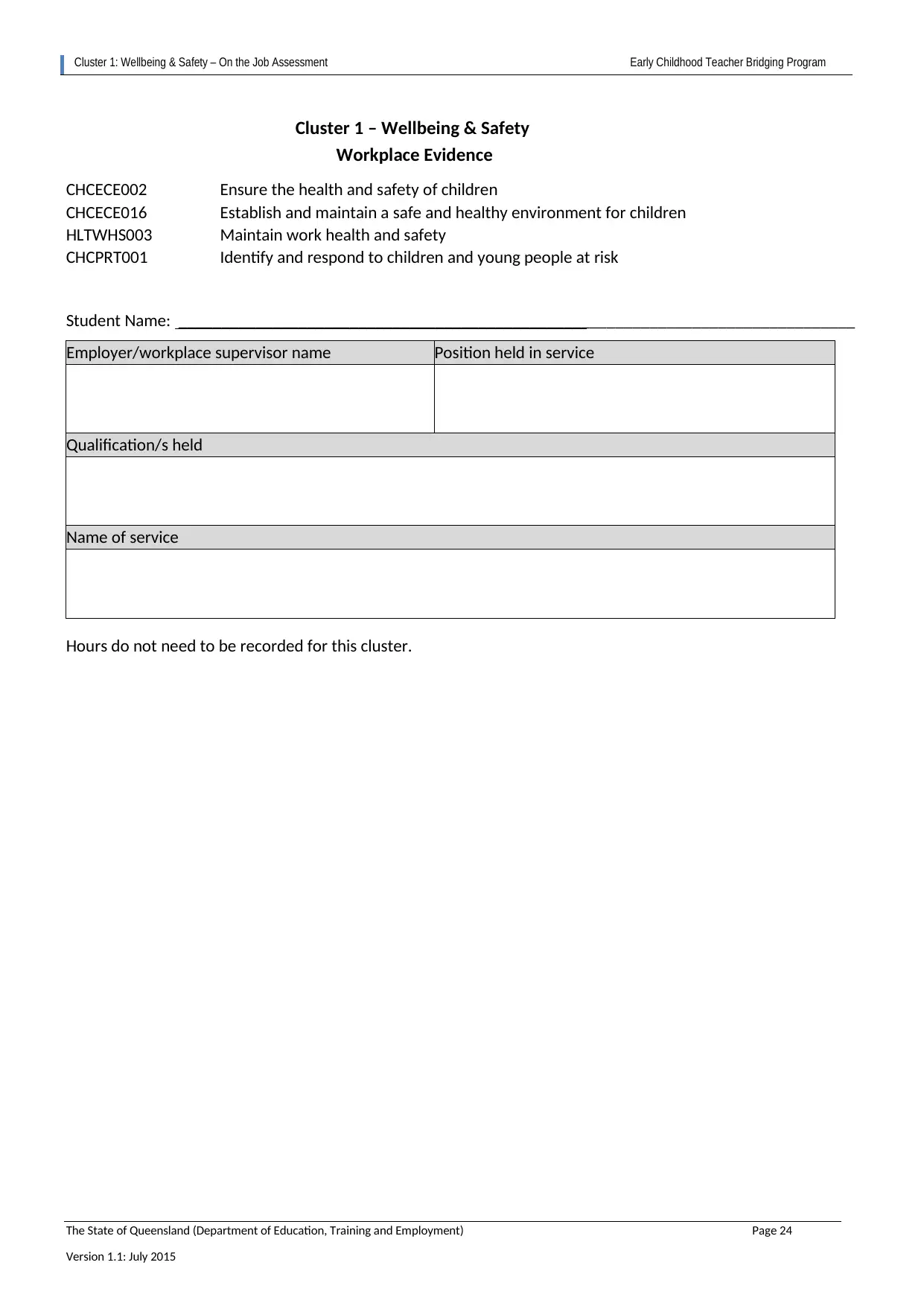
Cluster 1: Wellbeing & Safety – On the Job Assessment Early Childhood Teacher Bridging Program
The State of Queensland (Department of Education, Training and Employment) Page 24
Version 1.1: July 2015
Cluster 1 – Wellbeing & Safety
Workplace Evidence
CHCECE002 Ensure the health and safety of children
CHCECE016 Establish and maintain a safe and healthy environment for children
HLTWHS003 Maintain work health and safety
CHCPRT001 Identify and respond to children and young people at risk
Student Name: _______________________________________________________________________________
Employer/workplace supervisor name Position held in service
Qualification/s held
Name of service
Hours do not need to be recorded for this cluster.
The State of Queensland (Department of Education, Training and Employment) Page 24
Version 1.1: July 2015
Cluster 1 – Wellbeing & Safety
Workplace Evidence
CHCECE002 Ensure the health and safety of children
CHCECE016 Establish and maintain a safe and healthy environment for children
HLTWHS003 Maintain work health and safety
CHCPRT001 Identify and respond to children and young people at risk
Student Name: _______________________________________________________________________________
Employer/workplace supervisor name Position held in service
Qualification/s held
Name of service
Hours do not need to be recorded for this cluster.
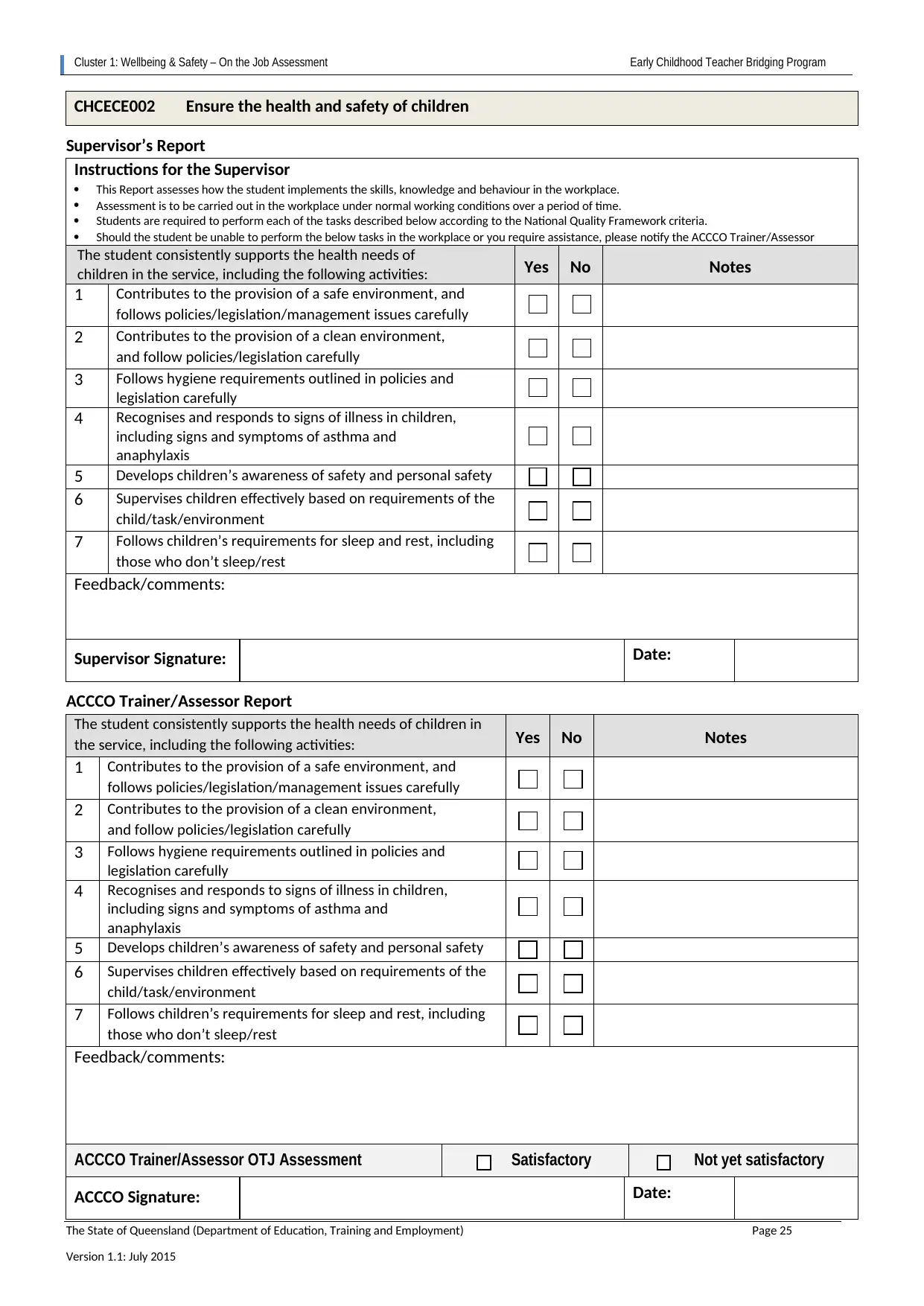
Cluster 1: Wellbeing & Safety – On the Job Assessment Early Childhood Teacher Bridging Program
The State of Queensland (Department of Education, Training and Employment) Page 25
Version 1.1: July 2015
CHCECE002 Ensure the health and safety of children
Supervisor’s Report
Instructions for the Supervisor
This Report assesses how the student implements the skills, knowledge and behaviour in the workplace.
Assessment is to be carried out in the workplace under normal working conditions over a period of time.
Students are required to perform each of the tasks described below according to the National Quality Framework criteria.
Should the student be unable to perform the below tasks in the workplace or you require assistance, please notify the ACCCO Trainer/Assessor
The student consistently supports the health needs of
children in the service, including the following activities: Yes No Notes
1 Contributes to the provision of a safe environment, and
follows policies/legislation/management issues carefully
2 Contributes to the provision of a clean environment,
and follow policies/legislation carefully
3 Follows hygiene requirements outlined in policies and
legislation carefully
4 Recognises and responds to signs of illness in children,
including signs and symptoms of asthma and
anaphylaxis
5 Develops children’s awareness of safety and personal safety
6 Supervises children effectively based on requirements of the
child/task/environment
7 Follows children’s requirements for sleep and rest, including
those who don’t sleep/rest
Feedback/comments:
Supervisor Signature: Date:
ACCCO Trainer/Assessor Report
The student consistently supports the health needs of children in
the service, including the following activities: Yes No Notes
1 Contributes to the provision of a safe environment, and
follows policies/legislation/management issues carefully
2 Contributes to the provision of a clean environment,
and follow policies/legislation carefully
3 Follows hygiene requirements outlined in policies and
legislation carefully
4 Recognises and responds to signs of illness in children,
including signs and symptoms of asthma and
anaphylaxis
5 Develops children’s awareness of safety and personal safety
6 Supervises children effectively based on requirements of the
child/task/environment
7 Follows children’s requirements for sleep and rest, including
those who don’t sleep/rest
Feedback/comments:
ACCCO Trainer/Assessor OTJ Assessment Satisfactory Not yet satisfactory
ACCCO Signature: Date:
The State of Queensland (Department of Education, Training and Employment) Page 25
Version 1.1: July 2015
CHCECE002 Ensure the health and safety of children
Supervisor’s Report
Instructions for the Supervisor
This Report assesses how the student implements the skills, knowledge and behaviour in the workplace.
Assessment is to be carried out in the workplace under normal working conditions over a period of time.
Students are required to perform each of the tasks described below according to the National Quality Framework criteria.
Should the student be unable to perform the below tasks in the workplace or you require assistance, please notify the ACCCO Trainer/Assessor
The student consistently supports the health needs of
children in the service, including the following activities: Yes No Notes
1 Contributes to the provision of a safe environment, and
follows policies/legislation/management issues carefully
2 Contributes to the provision of a clean environment,
and follow policies/legislation carefully
3 Follows hygiene requirements outlined in policies and
legislation carefully
4 Recognises and responds to signs of illness in children,
including signs and symptoms of asthma and
anaphylaxis
5 Develops children’s awareness of safety and personal safety
6 Supervises children effectively based on requirements of the
child/task/environment
7 Follows children’s requirements for sleep and rest, including
those who don’t sleep/rest
Feedback/comments:
Supervisor Signature: Date:
ACCCO Trainer/Assessor Report
The student consistently supports the health needs of children in
the service, including the following activities: Yes No Notes
1 Contributes to the provision of a safe environment, and
follows policies/legislation/management issues carefully
2 Contributes to the provision of a clean environment,
and follow policies/legislation carefully
3 Follows hygiene requirements outlined in policies and
legislation carefully
4 Recognises and responds to signs of illness in children,
including signs and symptoms of asthma and
anaphylaxis
5 Develops children’s awareness of safety and personal safety
6 Supervises children effectively based on requirements of the
child/task/environment
7 Follows children’s requirements for sleep and rest, including
those who don’t sleep/rest
Feedback/comments:
ACCCO Trainer/Assessor OTJ Assessment Satisfactory Not yet satisfactory
ACCCO Signature: Date:
Secure Best Marks with AI Grader
Need help grading? Try our AI Grader for instant feedback on your assignments.
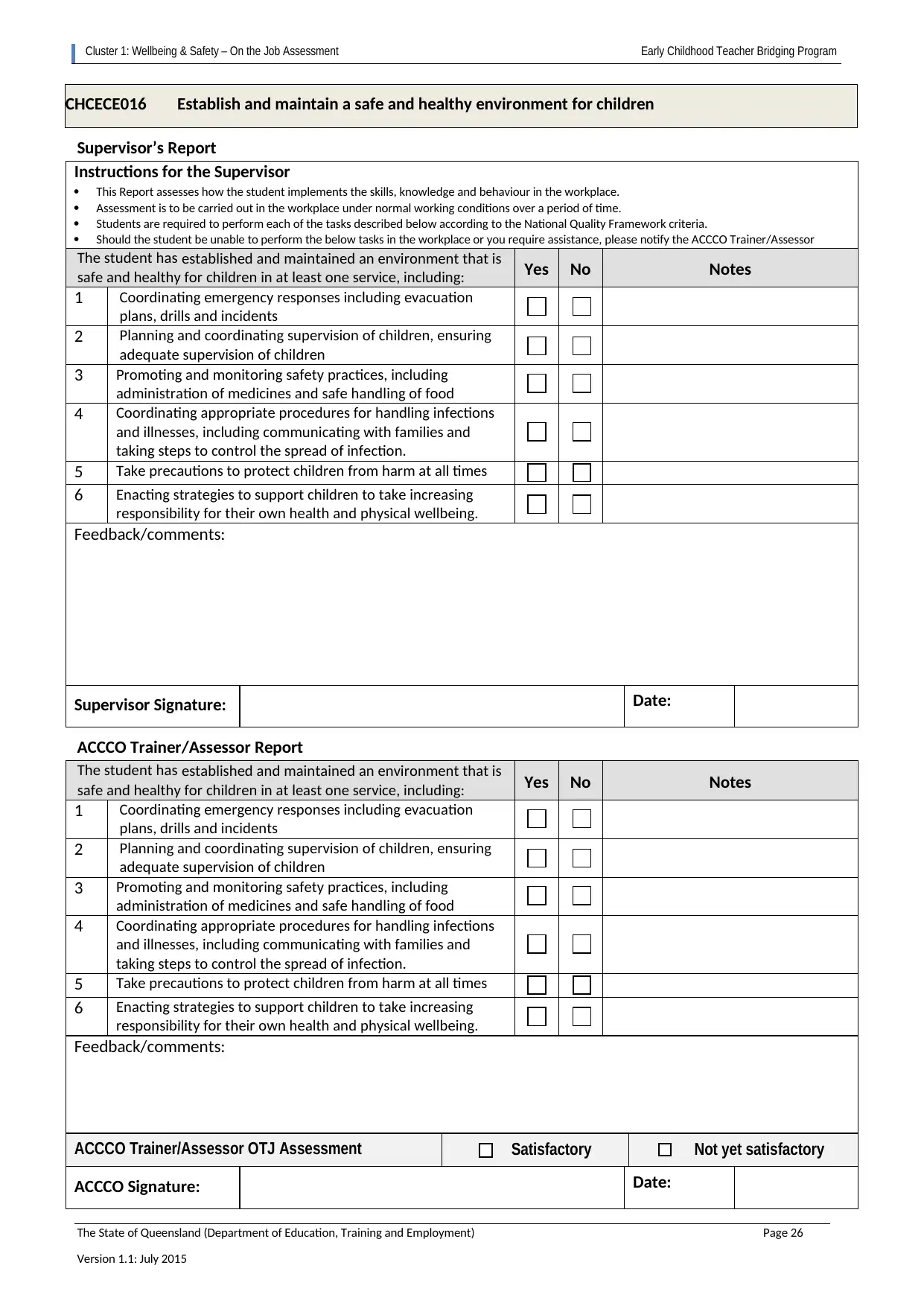
Cluster 1: Wellbeing & Safety – On the Job Assessment Early Childhood Teacher Bridging Program
The State of Queensland (Department of Education, Training and Employment) Page 26
Version 1.1: July 2015
CHCECE016 Establish and maintain a safe and healthy environment for children
Supervisor’s Report
Instructions for the Supervisor
This Report assesses how the student implements the skills, knowledge and behaviour in the workplace.
Assessment is to be carried out in the workplace under normal working conditions over a period of time.
Students are required to perform each of the tasks described below according to the National Quality Framework criteria.
Should the student be unable to perform the below tasks in the workplace or you require assistance, please notify the ACCCO Trainer/Assessor
The student has established and maintained an environment that is
safe and healthy for children in at least one service, including: Yes No Notes
1 Coordinating emergency responses including evacuation
plans, drills and incidents
2 Planning and coordinating supervision of children, ensuring
adequate supervision of children
3 Promoting and monitoring safety practices, including
administration of medicines and safe handling of food
4 Coordinating appropriate procedures for handling infections
and illnesses, including communicating with families and
taking steps to control the spread of infection.
5 Take precautions to protect children from harm at all times
6 Enacting strategies to support children to take increasing
responsibility for their own health and physical wellbeing.
Feedback/comments:
Supervisor Signature: Date:
ACCCO Trainer/Assessor Report
The student has established and maintained an environment that is
safe and healthy for children in at least one service, including: Yes No Notes
1 Coordinating emergency responses including evacuation
plans, drills and incidents
2 Planning and coordinating supervision of children, ensuring
adequate supervision of children
3 Promoting and monitoring safety practices, including
administration of medicines and safe handling of food
4 Coordinating appropriate procedures for handling infections
and illnesses, including communicating with families and
taking steps to control the spread of infection.
5 Take precautions to protect children from harm at all times
6 Enacting strategies to support children to take increasing
responsibility for their own health and physical wellbeing.
Feedback/comments:
ACCCO Trainer/Assessor OTJ Assessment Satisfactory Not yet satisfactory
ACCCO Signature: Date:
The State of Queensland (Department of Education, Training and Employment) Page 26
Version 1.1: July 2015
CHCECE016 Establish and maintain a safe and healthy environment for children
Supervisor’s Report
Instructions for the Supervisor
This Report assesses how the student implements the skills, knowledge and behaviour in the workplace.
Assessment is to be carried out in the workplace under normal working conditions over a period of time.
Students are required to perform each of the tasks described below according to the National Quality Framework criteria.
Should the student be unable to perform the below tasks in the workplace or you require assistance, please notify the ACCCO Trainer/Assessor
The student has established and maintained an environment that is
safe and healthy for children in at least one service, including: Yes No Notes
1 Coordinating emergency responses including evacuation
plans, drills and incidents
2 Planning and coordinating supervision of children, ensuring
adequate supervision of children
3 Promoting and monitoring safety practices, including
administration of medicines and safe handling of food
4 Coordinating appropriate procedures for handling infections
and illnesses, including communicating with families and
taking steps to control the spread of infection.
5 Take precautions to protect children from harm at all times
6 Enacting strategies to support children to take increasing
responsibility for their own health and physical wellbeing.
Feedback/comments:
Supervisor Signature: Date:
ACCCO Trainer/Assessor Report
The student has established and maintained an environment that is
safe and healthy for children in at least one service, including: Yes No Notes
1 Coordinating emergency responses including evacuation
plans, drills and incidents
2 Planning and coordinating supervision of children, ensuring
adequate supervision of children
3 Promoting and monitoring safety practices, including
administration of medicines and safe handling of food
4 Coordinating appropriate procedures for handling infections
and illnesses, including communicating with families and
taking steps to control the spread of infection.
5 Take precautions to protect children from harm at all times
6 Enacting strategies to support children to take increasing
responsibility for their own health and physical wellbeing.
Feedback/comments:
ACCCO Trainer/Assessor OTJ Assessment Satisfactory Not yet satisfactory
ACCCO Signature: Date:
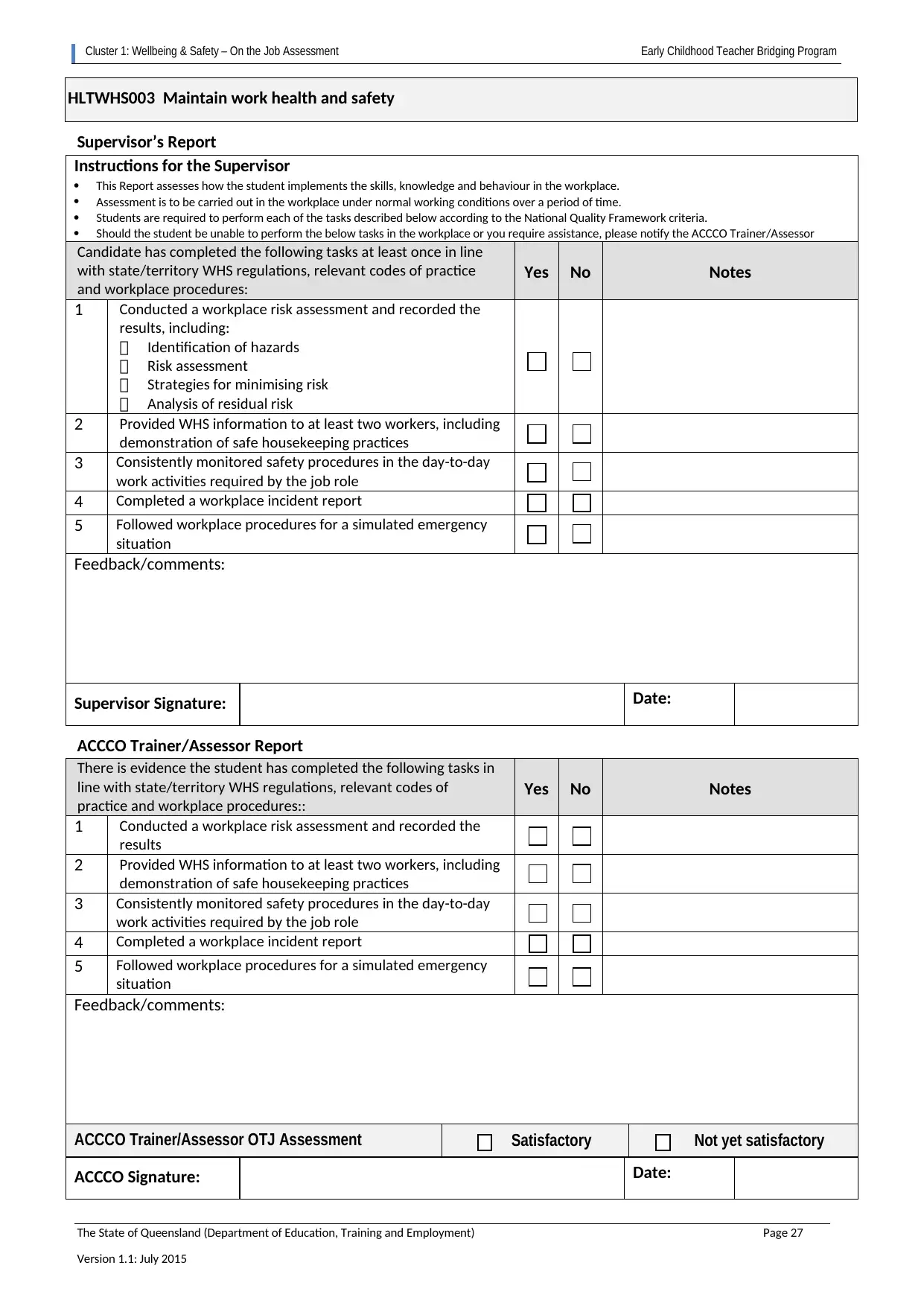
Cluster 1: Wellbeing & Safety – On the Job Assessment Early Childhood Teacher Bridging Program
The State of Queensland (Department of Education, Training and Employment) Page 27
Version 1.1: July 2015
HLTWHS003 Maintain work health and safety
Supervisor’s Report
Instructions for the Supervisor
This Report assesses how the student implements the skills, knowledge and behaviour in the workplace.
Assessment is to be carried out in the workplace under normal working conditions over a period of time.
Students are required to perform each of the tasks described below according to the National Quality Framework criteria.
Should the student be unable to perform the below tasks in the workplace or you require assistance, please notify the ACCCO Trainer/Assessor
Candidate has completed the following tasks at least once in line
with state/territory WHS regulations, relevant codes of practice
and workplace procedures:
Yes No Notes
1 Conducted a workplace risk assessment and recorded the
results, including:
Identification of hazards
Risk assessment
Strategies for minimising risk
Analysis of residual risk
2 Provided WHS information to at least two workers, including
demonstration of safe housekeeping practices
3 Consistently monitored safety procedures in the day-to-day
work activities required by the job role
4 Completed a workplace incident report
5 Followed workplace procedures for a simulated emergency
situation
Feedback/comments:
Supervisor Signature: Date:
ACCCO Trainer/Assessor Report
There is evidence the student has completed the following tasks in
line with state/territory WHS regulations, relevant codes of
practice and workplace procedures::
Yes No Notes
1 Conducted a workplace risk assessment and recorded the
results
2 Provided WHS information to at least two workers, including
demonstration of safe housekeeping practices
3 Consistently monitored safety procedures in the day-to-day
work activities required by the job role
4 Completed a workplace incident report
5 Followed workplace procedures for a simulated emergency
situation
Feedback/comments:
ACCCO Trainer/Assessor OTJ Assessment Satisfactory Not yet satisfactory
ACCCO Signature: Date:
The State of Queensland (Department of Education, Training and Employment) Page 27
Version 1.1: July 2015
HLTWHS003 Maintain work health and safety
Supervisor’s Report
Instructions for the Supervisor
This Report assesses how the student implements the skills, knowledge and behaviour in the workplace.
Assessment is to be carried out in the workplace under normal working conditions over a period of time.
Students are required to perform each of the tasks described below according to the National Quality Framework criteria.
Should the student be unable to perform the below tasks in the workplace or you require assistance, please notify the ACCCO Trainer/Assessor
Candidate has completed the following tasks at least once in line
with state/territory WHS regulations, relevant codes of practice
and workplace procedures:
Yes No Notes
1 Conducted a workplace risk assessment and recorded the
results, including:
Identification of hazards
Risk assessment
Strategies for minimising risk
Analysis of residual risk
2 Provided WHS information to at least two workers, including
demonstration of safe housekeeping practices
3 Consistently monitored safety procedures in the day-to-day
work activities required by the job role
4 Completed a workplace incident report
5 Followed workplace procedures for a simulated emergency
situation
Feedback/comments:
Supervisor Signature: Date:
ACCCO Trainer/Assessor Report
There is evidence the student has completed the following tasks in
line with state/territory WHS regulations, relevant codes of
practice and workplace procedures::
Yes No Notes
1 Conducted a workplace risk assessment and recorded the
results
2 Provided WHS information to at least two workers, including
demonstration of safe housekeeping practices
3 Consistently monitored safety procedures in the day-to-day
work activities required by the job role
4 Completed a workplace incident report
5 Followed workplace procedures for a simulated emergency
situation
Feedback/comments:
ACCCO Trainer/Assessor OTJ Assessment Satisfactory Not yet satisfactory
ACCCO Signature: Date:

Cluster 1: Wellbeing & Safety – On the Job Assessment Early Childhood Teacher Bridging Program
The State of Queensland (Department of Education, Training and Employment) Page 28
Version 1.1: July 2015
CHCPRT001 Identify and respond to children and young people at risk
Supervisor’s Report
Instructions for the Supervisor
This Report assesses how the student implements the skills, knowledge and behaviour in the workplace.
Assessment is to be carried out in the workplace under normal working conditions over a period of time.
Students are required to perform each of the tasks described below according to the National Quality Framework criteria.
Should the student be unable to perform the below tasks in the workplace or you require assistance, please notify the ACCCO
Trainer/Assessor
The student has implemented work practices which support the
protection of children and young people, including: Yes No Notes
1 Complies with regulations, legislation and duty of care
responsibility
2 Provides appropriate responses in the protection of children
and young people
3 Read and interpreted the procedures for reporting children at
risk in line with organisational expectations and legislative
requirements
4 Uses child focused work practices routinely to uphold the
rights of children and young people
Feedback/comments:
Supervisor Signature: Date:
ACCCO Trainer/Assessor Report
The student has implemented work practices which support the
protection of children and young people, including: Yes No Notes
1 Complies with regulations, legislation and duty of care
responsibility
2 Provides appropriate responses in the protection of children
and young people
3 Read and interpreted the procedures for reporting children at
risk in line with organisational expectations and legislative
requirements
4 Uses child focused work practices routinely to uphold the
rights of children and young people
Feedback/comments:
ACCCO Trainer/Assessor OTJ Assessment Satisfactory Not yet satisfactory
ACCCO Signature: Date:
The State of Queensland (Department of Education, Training and Employment) Page 28
Version 1.1: July 2015
CHCPRT001 Identify and respond to children and young people at risk
Supervisor’s Report
Instructions for the Supervisor
This Report assesses how the student implements the skills, knowledge and behaviour in the workplace.
Assessment is to be carried out in the workplace under normal working conditions over a period of time.
Students are required to perform each of the tasks described below according to the National Quality Framework criteria.
Should the student be unable to perform the below tasks in the workplace or you require assistance, please notify the ACCCO
Trainer/Assessor
The student has implemented work practices which support the
protection of children and young people, including: Yes No Notes
1 Complies with regulations, legislation and duty of care
responsibility
2 Provides appropriate responses in the protection of children
and young people
3 Read and interpreted the procedures for reporting children at
risk in line with organisational expectations and legislative
requirements
4 Uses child focused work practices routinely to uphold the
rights of children and young people
Feedback/comments:
Supervisor Signature: Date:
ACCCO Trainer/Assessor Report
The student has implemented work practices which support the
protection of children and young people, including: Yes No Notes
1 Complies with regulations, legislation and duty of care
responsibility
2 Provides appropriate responses in the protection of children
and young people
3 Read and interpreted the procedures for reporting children at
risk in line with organisational expectations and legislative
requirements
4 Uses child focused work practices routinely to uphold the
rights of children and young people
Feedback/comments:
ACCCO Trainer/Assessor OTJ Assessment Satisfactory Not yet satisfactory
ACCCO Signature: Date:
Paraphrase This Document
Need a fresh take? Get an instant paraphrase of this document with our AI Paraphraser

ECTBP Cluster 1: Wellbeing and Safety
Overall Assessment Report
CHCECE002 Ensure the health and safety of children
CHCECE016 Establish and maintain a safe and healthy environment for children
HLTWHS003 Maintain work health and safety
CHCPRT001 Identify and respond to children and young people at risk
For the student to complete prior to submitting this assessment:
For the ACCCO Trainer/Assessor to complete after assessment has been completed:
Student Name:
Approved Workplace:
Instructions for the
student: To be deemed competent in this unit, students are required to satisfactorily complete each of
the following…
Part A - Written answers
Part B – On the job Assessment (both supervisor and ACCCO Trainer reports)
Declaration of Authenticity
Any assessment recorded on this document is invalid without this declaration being complete
I declare that the assessment item I have submitted for this unit is entirely my own work. If there is evidence that it is not my
work, I understand my enrolment in the unit will be cancelled.
I understand it is my responsibility to keep a copy of this assessment until I graduate, and provide this copy to ACCCO at
their request. If I am unable to provide a copy for any reason, then I will be required to complete additional assessment
Student Signature: Date:
ACCCO Trainer/
Assessor Name:
Outcome of assessment tasks completed by the student:
(Trainer/Assessor to transfer results from assessment documents) Satisfactory Not Satisfactory
Part A
Part B
Overall, assessment is: Valid Authentic Current Sufficient
Overall assessment result: Competent Not Yet Competent
Feedback to student:
ACCCO Trainer/
Assessor Signature: Date:
Overall Assessment Report
CHCECE002 Ensure the health and safety of children
CHCECE016 Establish and maintain a safe and healthy environment for children
HLTWHS003 Maintain work health and safety
CHCPRT001 Identify and respond to children and young people at risk
For the student to complete prior to submitting this assessment:
For the ACCCO Trainer/Assessor to complete after assessment has been completed:
Student Name:
Approved Workplace:
Instructions for the
student: To be deemed competent in this unit, students are required to satisfactorily complete each of
the following…
Part A - Written answers
Part B – On the job Assessment (both supervisor and ACCCO Trainer reports)
Declaration of Authenticity
Any assessment recorded on this document is invalid without this declaration being complete
I declare that the assessment item I have submitted for this unit is entirely my own work. If there is evidence that it is not my
work, I understand my enrolment in the unit will be cancelled.
I understand it is my responsibility to keep a copy of this assessment until I graduate, and provide this copy to ACCCO at
their request. If I am unable to provide a copy for any reason, then I will be required to complete additional assessment
Student Signature: Date:
ACCCO Trainer/
Assessor Name:
Outcome of assessment tasks completed by the student:
(Trainer/Assessor to transfer results from assessment documents) Satisfactory Not Satisfactory
Part A
Part B
Overall, assessment is: Valid Authentic Current Sufficient
Overall assessment result: Competent Not Yet Competent
Feedback to student:
ACCCO Trainer/
Assessor Signature: Date:
1 out of 38
Your All-in-One AI-Powered Toolkit for Academic Success.
+13062052269
info@desklib.com
Available 24*7 on WhatsApp / Email
![[object Object]](/_next/static/media/star-bottom.7253800d.svg)
Unlock your academic potential
© 2024 | Zucol Services PVT LTD | All rights reserved.




